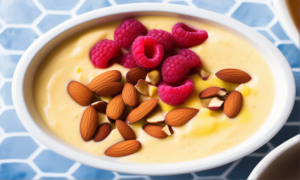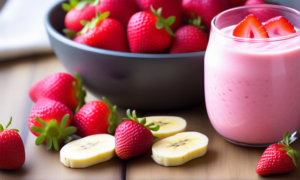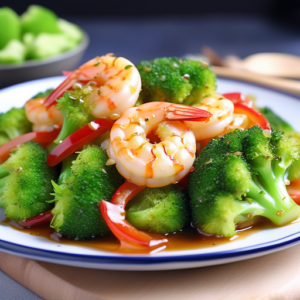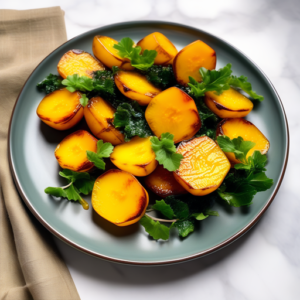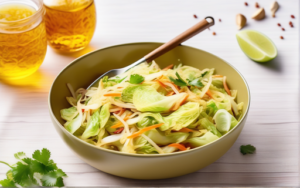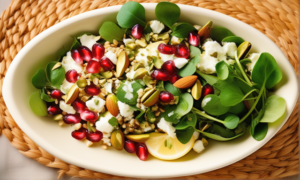 Farro Salad with Arugula, Artichokes & Pistachios
Experience the ease and deliciousness of this farro salad, made effortlessly with precooked farro. The best part? You can prepare and serve it in the same bowl, keeping cleanup to a minimum!
Ingredients:
1 tablespoon lemon juice
1 tablespoon extra-virgin olive oil
¾ cup cooked farro
1 ½ cups packed baby arugula
¼ cup packed small fresh mint leaves
2 tablespoons thinly sliced fresh basil
1 canned whole artichoke heart (or 4 quarters), rinsed and chopped
⅛ teaspoon salt
2 tablespoons chopped salted dry-roasted pistachios
1 ½ tablespoons pomegranate seeds (arils) or dried cranberries
¾ ounce soft goat cheese, crumbled (2 tablespoons)
Directions:
Whisk lemon juice and oil in a salad bowl.
Stir in farro, arugula, mint, basil, artichoke, and salt.
Sprinkle with pistachios, pomegranate seeds, and goat cheese.
Benefits for Diabetes:This farro salad is a diabetes-friendly choice due to its low glycemic index. Farro provides complex carbohydrates, which are slowly absorbed, helping manage blood sugar levels. Additionally, the inclusion of arugula and other fresh herbs brings in essential nutrients without spiking blood sugar. The healthy fats from olive oil and the crunch of pistachios add flavor and satiety, making it a well-balanced option for individuals with diabetes.
Farro Salad with Arugula, Artichokes & Pistachios
Experience the ease and deliciousness of this farro salad, made effortlessly with precooked farro. The best part? You can prepare and serve it in the same bowl, keeping cleanup to a minimum!
Ingredients:
1 tablespoon lemon juice
1 tablespoon extra-virgin olive oil
¾ cup cooked farro
1 ½ cups packed baby arugula
¼ cup packed small fresh mint leaves
2 tablespoons thinly sliced fresh basil
1 canned whole artichoke heart (or 4 quarters), rinsed and chopped
⅛ teaspoon salt
2 tablespoons chopped salted dry-roasted pistachios
1 ½ tablespoons pomegranate seeds (arils) or dried cranberries
¾ ounce soft goat cheese, crumbled (2 tablespoons)
Directions:
Whisk lemon juice and oil in a salad bowl.
Stir in farro, arugula, mint, basil, artichoke, and salt.
Sprinkle with pistachios, pomegranate seeds, and goat cheese.
Benefits for Diabetes:This farro salad is a diabetes-friendly choice due to its low glycemic index. Farro provides complex carbohydrates, which are slowly absorbed, helping manage blood sugar levels. Additionally, the inclusion of arugula and other fresh herbs brings in essential nutrients without spiking blood sugar. The healthy fats from olive oil and the crunch of pistachios add flavor and satiety, making it a well-balanced option for individuals with diabetes.
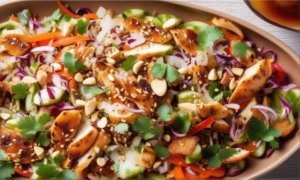 Sesame Kohlrabi & Chicken Salad Recipe
Experience a delightful blend of flavors and textures with our Sesame Kohlrabi & Chicken Salad. Kohlrabi, a bulbous vegetable with a sweet, mild taste, combines harmoniously with almonds to bring a satisfying crunch to this crowd-pleaser. For a versatile twist, you can substitute chicken with baked tofu or shrimp.
Ingredients:
¼ cup rice vinegar
3 tablespoons 50%-less-sodium tamari
1 tablespoon chile-garlic sauce
1 tablespoon grated orange zest
½ cup finely chopped fresh cilantro, divided
2 tablespoons grapeseed or canola oil
2 tablespoons toasted sesame oil
1 large kohlrabi (about 1 pound), peeled and cut into matchsticks
3 cups shredded napa cabbage
3 cups shredded cooked chicken
1 cup grated carrots
1 cup thinly sliced snow peas
¼ cup sliced almonds, toasted
1 tablespoon sesame seeds, toasted
Directions:
In a large bowl, whisk together rice vinegar, tamari, chile-garlic sauce, orange zest, and ¼ cup of cilantro.
Slowly whisk in grapeseed (or canola) oil and toasted sesame oil.
Stir in kohlrabi, napa cabbage, cooked chicken, grated carrots, and snow peas.
Serve the salad topped with toasted almonds, sesame seeds, and the remaining 1/4 cup of cilantro.
Why It's Beneficial for Diabetics:This Sesame Kohlrabi & Chicken Salad is not only a flavorful delight but also a diabetes-friendly option. The inclusion of kohlrabi, a low-carb vegetable, helps regulate blood sugar levels. Additionally, the nutrient-rich ingredients, such as cabbage, chicken, and almonds, contribute to a balanced and diabetes-conscious meal. The salad's vibrant mix of flavors ensures a satisfying experience without compromising health, making it an excellent choice for individuals managing diabetes.
Sesame Kohlrabi & Chicken Salad Recipe
Experience a delightful blend of flavors and textures with our Sesame Kohlrabi & Chicken Salad. Kohlrabi, a bulbous vegetable with a sweet, mild taste, combines harmoniously with almonds to bring a satisfying crunch to this crowd-pleaser. For a versatile twist, you can substitute chicken with baked tofu or shrimp.
Ingredients:
¼ cup rice vinegar
3 tablespoons 50%-less-sodium tamari
1 tablespoon chile-garlic sauce
1 tablespoon grated orange zest
½ cup finely chopped fresh cilantro, divided
2 tablespoons grapeseed or canola oil
2 tablespoons toasted sesame oil
1 large kohlrabi (about 1 pound), peeled and cut into matchsticks
3 cups shredded napa cabbage
3 cups shredded cooked chicken
1 cup grated carrots
1 cup thinly sliced snow peas
¼ cup sliced almonds, toasted
1 tablespoon sesame seeds, toasted
Directions:
In a large bowl, whisk together rice vinegar, tamari, chile-garlic sauce, orange zest, and ¼ cup of cilantro.
Slowly whisk in grapeseed (or canola) oil and toasted sesame oil.
Stir in kohlrabi, napa cabbage, cooked chicken, grated carrots, and snow peas.
Serve the salad topped with toasted almonds, sesame seeds, and the remaining 1/4 cup of cilantro.
Why It's Beneficial for Diabetics:This Sesame Kohlrabi & Chicken Salad is not only a flavorful delight but also a diabetes-friendly option. The inclusion of kohlrabi, a low-carb vegetable, helps regulate blood sugar levels. Additionally, the nutrient-rich ingredients, such as cabbage, chicken, and almonds, contribute to a balanced and diabetes-conscious meal. The salad's vibrant mix of flavors ensures a satisfying experience without compromising health, making it an excellent choice for individuals managing diabetes.
 Unlock the Heart-Health Secrets: 10 Nutrient-Rich Breakfasts
Embark on a journey of heart-healthy mornings with these ten delightful and nutritious breakfast recipes. Nourish your heart and kickstart your day with a blend of flavors, nutrients, and wholesome ingredients.
1. Breakfast Beans with Microwave-Poached Egg
Indulge in the Gallo Pinto Delight, inspired by Costa Rican traditions. This savory blend of beans, barley, and a poached egg offers a protein-packed and satisfying start to your day.
View Recipe
2. Pineapple-Grapefruit Detox Smoothie
Revitalize your mornings with a burst of freshness. This detox smoothie, featuring pineapple, grapefruit, and spinach, not only hydrates but also provides a bounty of fiber for a heart-healthy kick.
View Recipe
3. Spinach & Egg Scramble with Raspberries
Fuel your body with a nutrient-rich scramble. The combination of protein-packed eggs, superfood raspberries, and nutrient-rich spinach creates a breakfast that supports your heart while keeping you full.
View Recipe
4. Everything Bagel Avocado Toast
Experience the marriage of everything bagel flavor and creamy avocado toast. This quick and easy breakfast combines taste with heart-healthy fats for a satisfying morning treat.
View Recipe
5. Heart-Healthy Two-Ingredient Banana Pancakes
Savor the simplicity of two-ingredient banana pancakes. With just eggs and banana, indulge in a grain-free and sugar-free pancake option that promotes heart health.
View Recipe
6. Heart-Healthy Peanut Butter and Banana Breakfast Sandwich:Combine the classic pairing of peanut butter and banana in a wholesome breakfast sandwich. Packed with protein and potassium, this sandwich is a heart-smart choice.
View Recipe
7. Heart-Boosting Mango-Almond Smoothie Bowl:Indulge in a vibrant smoothie bowl featuring mango and almonds. Rich in vitamins, minerals, and heart-healthy fats, this bowl is a delicious way to nourish your heart.
View Recipe
8. Heart-Boosting Fruit & Nut Oatmeal:Kickstart your day with a hearty bowl of oatmeal loaded with fruits and nuts. Oats are known to promote heart health, making this breakfast a comforting and nutritious choice.
View Recipe
9. Heart-Boosting Acai Bowl:Fuel your body with antioxidants and heart-healthy nutrients with acai bowl topped with a medley of fruits and nuts. A delicious and visually appealing breakfast for your heart.
View Recipe
10. Heart-Boosting Peanut Butter-Banana English Muffin:Savor the goodness of peanut butter and banana on a whole-grain English muffin. Quick, easy, and heart-boosting, this breakfast is perfect for those busy mornings.
View Recipe
Elevate your breakfast routine with these heart-healthy recipes and make each morning a step towards a healthier heart.
Unlock the Heart-Health Secrets: 10 Nutrient-Rich Breakfasts
Embark on a journey of heart-healthy mornings with these ten delightful and nutritious breakfast recipes. Nourish your heart and kickstart your day with a blend of flavors, nutrients, and wholesome ingredients.
1. Breakfast Beans with Microwave-Poached Egg
Indulge in the Gallo Pinto Delight, inspired by Costa Rican traditions. This savory blend of beans, barley, and a poached egg offers a protein-packed and satisfying start to your day.
View Recipe
2. Pineapple-Grapefruit Detox Smoothie
Revitalize your mornings with a burst of freshness. This detox smoothie, featuring pineapple, grapefruit, and spinach, not only hydrates but also provides a bounty of fiber for a heart-healthy kick.
View Recipe
3. Spinach & Egg Scramble with Raspberries
Fuel your body with a nutrient-rich scramble. The combination of protein-packed eggs, superfood raspberries, and nutrient-rich spinach creates a breakfast that supports your heart while keeping you full.
View Recipe
4. Everything Bagel Avocado Toast
Experience the marriage of everything bagel flavor and creamy avocado toast. This quick and easy breakfast combines taste with heart-healthy fats for a satisfying morning treat.
View Recipe
5. Heart-Healthy Two-Ingredient Banana Pancakes
Savor the simplicity of two-ingredient banana pancakes. With just eggs and banana, indulge in a grain-free and sugar-free pancake option that promotes heart health.
View Recipe
6. Heart-Healthy Peanut Butter and Banana Breakfast Sandwich:Combine the classic pairing of peanut butter and banana in a wholesome breakfast sandwich. Packed with protein and potassium, this sandwich is a heart-smart choice.
View Recipe
7. Heart-Boosting Mango-Almond Smoothie Bowl:Indulge in a vibrant smoothie bowl featuring mango and almonds. Rich in vitamins, minerals, and heart-healthy fats, this bowl is a delicious way to nourish your heart.
View Recipe
8. Heart-Boosting Fruit & Nut Oatmeal:Kickstart your day with a hearty bowl of oatmeal loaded with fruits and nuts. Oats are known to promote heart health, making this breakfast a comforting and nutritious choice.
View Recipe
9. Heart-Boosting Acai Bowl:Fuel your body with antioxidants and heart-healthy nutrients with acai bowl topped with a medley of fruits and nuts. A delicious and visually appealing breakfast for your heart.
View Recipe
10. Heart-Boosting Peanut Butter-Banana English Muffin:Savor the goodness of peanut butter and banana on a whole-grain English muffin. Quick, easy, and heart-boosting, this breakfast is perfect for those busy mornings.
View Recipe
Elevate your breakfast routine with these heart-healthy recipes and make each morning a step towards a healthier heart.
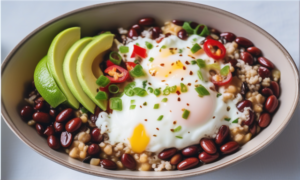 Breakfast Beans with Microwave-Poached Egg
Gallo Pinto Delight: A Flavorful Costa Rican Breakfast
Recipe:
Indulge in the savory goodness of Breakfast Beans with Microwave-Poached Egg, inspired by the Costa Rican classic, Gallo Pinto. The term translates to "spotted rooster," reflecting the dark beans amid the pale rice. While the traditional dish uses rice, our version features cooked barley for a nutritious twist. Feel free to substitute with any leftover cooked grain you have on hand.
Ingredients:
2 teaspoons canola oil
¼ cup chopped red bell pepper
2 chopped scallions, whites and greens separated
½ teaspoon ground cumin
¾ cup rinsed canned low-sodium black beans
½ cup cooked barley
½ cup low-sodium chicken broth or vegetable broth
⅛ teaspoon salt
⅛ teaspoon hot sauce
1 cup water, divided
1 teaspoon distilled white vinegar, divided
2 large eggs, divided
2 tablespoons shredded pepper Jack cheese
½ avocado, sliced
2 tablespoons coarsely chopped fresh cilantro
Directions:
Heat oil in a medium skillet; add bell pepper, scallion whites, and cumin. Cook until softened, stirring often (1 to 2 minutes).
Add black beans, cooked barley, broth, and salt. Cook until most liquid is absorbed (3 to 5 minutes). Stir in scallion greens and hot sauce. Divide between 2 bowls.
In a microwave-safe bowl, combine 1/2 cup water and 1/2 tsp. vinegar. Carefully crack 1 egg into the water, ensuring it's completely submerged. Microwave until the egg white is firm and the yolk is slightly runny (about 1 minute).
Remove the egg, pat dry, and place atop the bean mixture in one bowl. Repeat with the remaining water, vinegar, and egg.
Top each bowl with 1 Tbsp. cheese and 1/4 avocado. Sprinkle with cilantro if desired.
Breakfast Beans with Microwave-Poached Egg
Gallo Pinto Delight: A Flavorful Costa Rican Breakfast
Recipe:
Indulge in the savory goodness of Breakfast Beans with Microwave-Poached Egg, inspired by the Costa Rican classic, Gallo Pinto. The term translates to "spotted rooster," reflecting the dark beans amid the pale rice. While the traditional dish uses rice, our version features cooked barley for a nutritious twist. Feel free to substitute with any leftover cooked grain you have on hand.
Ingredients:
2 teaspoons canola oil
¼ cup chopped red bell pepper
2 chopped scallions, whites and greens separated
½ teaspoon ground cumin
¾ cup rinsed canned low-sodium black beans
½ cup cooked barley
½ cup low-sodium chicken broth or vegetable broth
⅛ teaspoon salt
⅛ teaspoon hot sauce
1 cup water, divided
1 teaspoon distilled white vinegar, divided
2 large eggs, divided
2 tablespoons shredded pepper Jack cheese
½ avocado, sliced
2 tablespoons coarsely chopped fresh cilantro
Directions:
Heat oil in a medium skillet; add bell pepper, scallion whites, and cumin. Cook until softened, stirring often (1 to 2 minutes).
Add black beans, cooked barley, broth, and salt. Cook until most liquid is absorbed (3 to 5 minutes). Stir in scallion greens and hot sauce. Divide between 2 bowls.
In a microwave-safe bowl, combine 1/2 cup water and 1/2 tsp. vinegar. Carefully crack 1 egg into the water, ensuring it's completely submerged. Microwave until the egg white is firm and the yolk is slightly runny (about 1 minute).
Remove the egg, pat dry, and place atop the bean mixture in one bowl. Repeat with the remaining water, vinegar, and egg.
Top each bowl with 1 Tbsp. cheese and 1/4 avocado. Sprinkle with cilantro if desired.
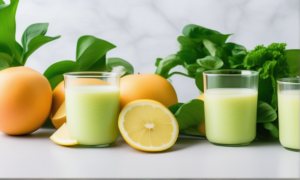 Pineapple-Grapefruit Detox Smoothie
Heart-Healthy Hydration Boost
Recipe:
Indulge in the refreshing Pineapple-Grapefruit Detox Smoothie, crafted with hydrating pineapple, grapefruit, and nutrient-packed spinach. This delightful blend not only quenches your thirst but also provides a bounty of fiber. The addition of electrolyte-rich coconut water serves as a dairy-free alternative, contributing to the smoothie's heart-healthy profile. For an extra-chilled experience, freeze coconut water into cubes before blending.
Ingredients:
1 cup plain coconut water
1 cup frozen diced pineapple
1 cup packed baby spinach
1 small grapefruit, peeled and segmented, plus any juice squeezed from the membranes
½ teaspoon grated fresh ginger
1 cup ice
Directions:
Combine coconut water, frozen pineapple, baby spinach, peeled and segmented grapefruit, ginger, and ice in a blender.
Puree the ingredients until smooth and frothy.
Heart Benefits:
This detox smoothie is not just a flavorful treat; it's also heart-friendly. The combination of pineapple, grapefruit, and spinach delivers essential minerals and fiber, promoting hydration and cardiovascular health. Coconut water adds electrolytes, making it a nourishing option for your heart.
Pineapple-Grapefruit Detox Smoothie
Heart-Healthy Hydration Boost
Recipe:
Indulge in the refreshing Pineapple-Grapefruit Detox Smoothie, crafted with hydrating pineapple, grapefruit, and nutrient-packed spinach. This delightful blend not only quenches your thirst but also provides a bounty of fiber. The addition of electrolyte-rich coconut water serves as a dairy-free alternative, contributing to the smoothie's heart-healthy profile. For an extra-chilled experience, freeze coconut water into cubes before blending.
Ingredients:
1 cup plain coconut water
1 cup frozen diced pineapple
1 cup packed baby spinach
1 small grapefruit, peeled and segmented, plus any juice squeezed from the membranes
½ teaspoon grated fresh ginger
1 cup ice
Directions:
Combine coconut water, frozen pineapple, baby spinach, peeled and segmented grapefruit, ginger, and ice in a blender.
Puree the ingredients until smooth and frothy.
Heart Benefits:
This detox smoothie is not just a flavorful treat; it's also heart-friendly. The combination of pineapple, grapefruit, and spinach delivers essential minerals and fiber, promoting hydration and cardiovascular health. Coconut water adds electrolytes, making it a nourishing option for your heart.
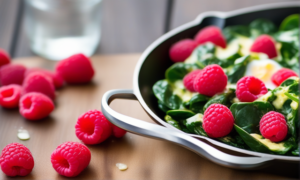 Spinach & Egg Scramble with Raspberries
Heart-Healthy Breakfast for Weight Loss
Recipe:
Indulge in a quick and nutritious egg scramble paired with wholesome bread, creating one of the best breakfasts for weight loss. This delightful dish combines protein-packed eggs, antioxidant-rich raspberries, filling whole-grain toast, and nutrient-packed spinach. The perfect blend of protein and fiber will keep you satisfied and energized throughout the morning.
Ingredients:
1 teaspoon canola oil
1 ½ cups baby spinach (1 1/2 ounces)
2 large eggs, lightly beaten
Pinch of kosher salt
Pinch of ground pepper
1 slice whole-grain bread, toasted
½ cup fresh raspberries
Directions:
Heat canola oil in a small nonstick skillet over medium-high heat.
Add spinach and cook until wilted, stirring often, 1 to 2 minutes. Transfer the spinach to a plate.
Wipe the pan clean, place over medium heat, and add lightly beaten eggs. Cook, stirring once or twice for even cooking, until just set, 1 to 2 minutes.
Stir in the cooked spinach, kosher salt, and ground pepper.
Serve the delightful scramble with toasted whole-grain bread and a side of fresh raspberries.
Heart Benefits:
The combination of nutrient-rich spinach and antioxidant-loaded raspberries contributes to heart health. The inclusion of whole-grain toast adds fiber, making this breakfast not only delicious but also beneficial for your cardiovascular well-being.
Spinach & Egg Scramble with Raspberries
Heart-Healthy Breakfast for Weight Loss
Recipe:
Indulge in a quick and nutritious egg scramble paired with wholesome bread, creating one of the best breakfasts for weight loss. This delightful dish combines protein-packed eggs, antioxidant-rich raspberries, filling whole-grain toast, and nutrient-packed spinach. The perfect blend of protein and fiber will keep you satisfied and energized throughout the morning.
Ingredients:
1 teaspoon canola oil
1 ½ cups baby spinach (1 1/2 ounces)
2 large eggs, lightly beaten
Pinch of kosher salt
Pinch of ground pepper
1 slice whole-grain bread, toasted
½ cup fresh raspberries
Directions:
Heat canola oil in a small nonstick skillet over medium-high heat.
Add spinach and cook until wilted, stirring often, 1 to 2 minutes. Transfer the spinach to a plate.
Wipe the pan clean, place over medium heat, and add lightly beaten eggs. Cook, stirring once or twice for even cooking, until just set, 1 to 2 minutes.
Stir in the cooked spinach, kosher salt, and ground pepper.
Serve the delightful scramble with toasted whole-grain bread and a side of fresh raspberries.
Heart Benefits:
The combination of nutrient-rich spinach and antioxidant-loaded raspberries contributes to heart health. The inclusion of whole-grain toast adds fiber, making this breakfast not only delicious but also beneficial for your cardiovascular well-being.
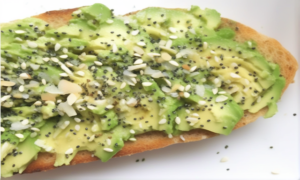 Everything Bagel Avocado Toast
Recipe:
Indulge in the perfect union of everything bagel flavor and the creamy goodness of avocado toast with this quick and healthy breakfast. Ideal for those busy mornings when you're on the go. Elevate it further by adding a poached or fried egg on top.
Ingredients:
¼ medium avocado, mashed
1 slice whole-grain bread, toasted
2 teaspoons everything bagel seasoning
Pinch of flaky sea salt (such as Maldon)
Directions:
Spread mashed avocado on the toasted bread.
Sprinkle with everything bagel seasoning.
Add a pinch of flaky sea salt.
Optional: Top with a poached or fried egg for an extra savory twist.
Everything Bagel Avocado Toast
Recipe:
Indulge in the perfect union of everything bagel flavor and the creamy goodness of avocado toast with this quick and healthy breakfast. Ideal for those busy mornings when you're on the go. Elevate it further by adding a poached or fried egg on top.
Ingredients:
¼ medium avocado, mashed
1 slice whole-grain bread, toasted
2 teaspoons everything bagel seasoning
Pinch of flaky sea salt (such as Maldon)
Directions:
Spread mashed avocado on the toasted bread.
Sprinkle with everything bagel seasoning.
Add a pinch of flaky sea salt.
Optional: Top with a poached or fried egg for an extra savory twist.
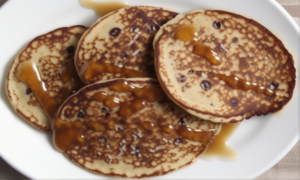 Heart-Healthy Two-Ingredient Banana Pancakes
Indulge in the simplicity and delightful taste of these two-ingredient banana pancakes, perfect for a healthy breakfast. Prepared with just eggs and bananas, these pancakes are not only grain-free but also free from added sugars.
Ingredients:
2 large eggs
1 medium banana
Instructions:
In a blender, combine the eggs and banana, blending until you achieve a smooth puree.
Lightly oil a spacious nonstick skillet (refer to Tip) and heat it over medium heat.
Spoon 2 tablespoons of batter for each pancake, creating 4 mounds in the pan.
Cook until bubbles emerge on the surface, and the edges appear dry, typically taking 2 to 4 minutes.
Gently flip the pancakes using a thin spatula and cook until the bottom is nicely browned, around 1 to 2 minutes more.
Transfer the golden pancakes to a plate.
Lightly oil the pan once more and repeat the cooking process with the remaining batter.
Heart-Healthy Note:
These two-ingredient banana pancakes not only satisfy your taste buds but also contribute to heart health. Bananas are rich in potassium, an essential mineral that aids in maintaining proper heart function and blood pressure. Additionally, the absence of added sugars in this recipe aligns with heart-friendly dietary choices, promoting overall cardiovascular well-being. Enjoy these pancakes as a nutritious and heart-conscious breakfast option.
Tip: Use a nonstick skillet to minimize the need for excessive oil, ensuring a healthier cooking process.
Heart-Healthy Two-Ingredient Banana Pancakes
Indulge in the simplicity and delightful taste of these two-ingredient banana pancakes, perfect for a healthy breakfast. Prepared with just eggs and bananas, these pancakes are not only grain-free but also free from added sugars.
Ingredients:
2 large eggs
1 medium banana
Instructions:
In a blender, combine the eggs and banana, blending until you achieve a smooth puree.
Lightly oil a spacious nonstick skillet (refer to Tip) and heat it over medium heat.
Spoon 2 tablespoons of batter for each pancake, creating 4 mounds in the pan.
Cook until bubbles emerge on the surface, and the edges appear dry, typically taking 2 to 4 minutes.
Gently flip the pancakes using a thin spatula and cook until the bottom is nicely browned, around 1 to 2 minutes more.
Transfer the golden pancakes to a plate.
Lightly oil the pan once more and repeat the cooking process with the remaining batter.
Heart-Healthy Note:
These two-ingredient banana pancakes not only satisfy your taste buds but also contribute to heart health. Bananas are rich in potassium, an essential mineral that aids in maintaining proper heart function and blood pressure. Additionally, the absence of added sugars in this recipe aligns with heart-friendly dietary choices, promoting overall cardiovascular well-being. Enjoy these pancakes as a nutritious and heart-conscious breakfast option.
Tip: Use a nonstick skillet to minimize the need for excessive oil, ensuring a healthier cooking process.
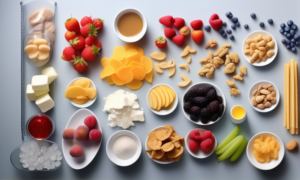 12 Snacks Suitable for Diabetics, Recommended for Regular Stocking at Home
Diabetes patients need to maintain a sense of fullness to avoid low blood sugar and overeating. Here are 12 snacks with strong satiety, minimal impact on blood sugar, and recommended for storage.
1. Tofu Jerky
Rich in nutrients, containing high-quality protein and calcium.
Natural functional ingredients like soy dietary fiber, soy isoflavones, and soy oligosaccharides slow down glucose absorption.
Snack: Not exceeding 100 grams, choose low-salt, sugar-free tofu jerky.
2. Boiled Chickpeas
Known as the "king of beans," rich in high-quality protein and dietary fiber.
Low glycemic index (GI=36), low in calories, and provides strong satiety.
Snack: Not exceeding 50 chickpeas.
3. Boiled Eggs
High satiety, rich in protein.
Preferably boiled for 7 minutes until the yolk is nearly fully solidified for optimal nutritional value.
Snack: 1 egg.
4. Tomatoes
Low energy, slow glycemic impact, rich in vitamin C and lycopene.
Snack: 1 large tomato or 15-20 cherry tomatoes.
5. Apples
Contains polyphenols for stable blood sugar.
Rich in dietary fiber, beneficial for preventing heart disease and constipation.
Snack: One fist-sized apple, preferably Fuji apples for higher sweetness.
6. Cucumber
Low calorie, high in dietary fiber, slow glycemic impact.
Suitable for all blood sugar levels.
Snack: 1 cucumber.
7. Grapefruit
Low-calorie, slow glycemic impact, rich in various nutrients.
Suitable for diabetics and those aiming for weight loss.
Snack: 1-2 segments, each about 100 grams.
8. Beef Jerky
Rich in protein and heme iron.
Homemade is preferred to avoid added sugar and salt.
Snack: 3-4 pieces, each about 15 grams.
9. Soda Crackers
Suitable for diabetics with fewer additives.
Snack: Not exceeding 4 pieces.
10. Whole Wheat Bread
Choose rye or whole wheat bread for better postprandial blood sugar control.
Read food labels, snack: about 1 slice, not exceeding 150 calories.
11. Milk or Yogurt
Milk is rich in protein and calcium, aiding in stabilizing blood sugar.
Yogurt is a quality snack; check protein and carbohydrate content.
Snack: 1 cup, about 250 ml, choose plain milk or yogurt.
12. Plain Nuts
Rich in unsaturated fatty acids, protein, vitamins, minerals, and dietary fiber.
Moderate consumption helps prevent atherosclerosis.
Weekly intake: 50-70 grams, Snack: 2 walnuts, 15 almonds, 4 hazelnuts, 30 plain pistachios, or 15-18 peanuts each time.
Note: Daily snack intake should be around 1/10 of the total daily energy intake, equivalent to 1 fist-sized apple + 100 grams of plain yogurt + 2 walnuts.
12 Snacks Suitable for Diabetics, Recommended for Regular Stocking at Home
Diabetes patients need to maintain a sense of fullness to avoid low blood sugar and overeating. Here are 12 snacks with strong satiety, minimal impact on blood sugar, and recommended for storage.
1. Tofu Jerky
Rich in nutrients, containing high-quality protein and calcium.
Natural functional ingredients like soy dietary fiber, soy isoflavones, and soy oligosaccharides slow down glucose absorption.
Snack: Not exceeding 100 grams, choose low-salt, sugar-free tofu jerky.
2. Boiled Chickpeas
Known as the "king of beans," rich in high-quality protein and dietary fiber.
Low glycemic index (GI=36), low in calories, and provides strong satiety.
Snack: Not exceeding 50 chickpeas.
3. Boiled Eggs
High satiety, rich in protein.
Preferably boiled for 7 minutes until the yolk is nearly fully solidified for optimal nutritional value.
Snack: 1 egg.
4. Tomatoes
Low energy, slow glycemic impact, rich in vitamin C and lycopene.
Snack: 1 large tomato or 15-20 cherry tomatoes.
5. Apples
Contains polyphenols for stable blood sugar.
Rich in dietary fiber, beneficial for preventing heart disease and constipation.
Snack: One fist-sized apple, preferably Fuji apples for higher sweetness.
6. Cucumber
Low calorie, high in dietary fiber, slow glycemic impact.
Suitable for all blood sugar levels.
Snack: 1 cucumber.
7. Grapefruit
Low-calorie, slow glycemic impact, rich in various nutrients.
Suitable for diabetics and those aiming for weight loss.
Snack: 1-2 segments, each about 100 grams.
8. Beef Jerky
Rich in protein and heme iron.
Homemade is preferred to avoid added sugar and salt.
Snack: 3-4 pieces, each about 15 grams.
9. Soda Crackers
Suitable for diabetics with fewer additives.
Snack: Not exceeding 4 pieces.
10. Whole Wheat Bread
Choose rye or whole wheat bread for better postprandial blood sugar control.
Read food labels, snack: about 1 slice, not exceeding 150 calories.
11. Milk or Yogurt
Milk is rich in protein and calcium, aiding in stabilizing blood sugar.
Yogurt is a quality snack; check protein and carbohydrate content.
Snack: 1 cup, about 250 ml, choose plain milk or yogurt.
12. Plain Nuts
Rich in unsaturated fatty acids, protein, vitamins, minerals, and dietary fiber.
Moderate consumption helps prevent atherosclerosis.
Weekly intake: 50-70 grams, Snack: 2 walnuts, 15 almonds, 4 hazelnuts, 30 plain pistachios, or 15-18 peanuts each time.
Note: Daily snack intake should be around 1/10 of the total daily energy intake, equivalent to 1 fist-sized apple + 100 grams of plain yogurt + 2 walnuts.
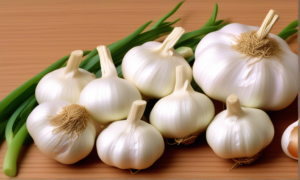 Unraveling the Myth: Is Garlic Detrimental for Diabetes? Doctor's Advice on 4 Foods to Limit for Blood Sugar Control
Introduction:Diabetes, a chronic metabolic disorder with an elusive origin, has emerged as a global health concern. According to statistics from the International Diabetes Federation, the global diabetic population has reached a staggering 425 million, with over 150 million in China alone. Maintaining elevated blood sugar levels not only affects vital organs like the brain, heart, blood vessels, kidneys, and liver but can also lead to abnormalities in various bodily systems.
While diabetes itself isn't terrifying, the potential complications it triggers can significantly compromise overall health. For individuals with diabetes, dietary choices play a pivotal role, requiring careful attention to blood sugar control. There's a common belief that garlic is a diabetes "trigger," allegedly causing the onset of diabetes. But is there any scientific basis for this claim?
Factors Contributing to the Rising Diabetes Cases:
Unhealthy Lifestyle:Modern sedentary lifestyles, high-sugar, high-fat diets, lack of exercise, and chronic stress contribute to widespread obesity, increasing the risk of diabetes.
Genetic Factors:Diabetes has a substantial genetic component. A family history of diabetes elevates the risk of developing the condition.
Aging Population:Advances in medical technology leading to longer lifespans contribute to an aging population, increasing the risk of diabetes in older individuals.
Environmental Factors:Environmental pollution, exposure to chemicals, and changes in dietary patterns also impact the risk of developing diabetes.
Common Symptoms of Diabetes:
Polydipsia (Increased Thirst):Elevated blood sugar stimulates the thirst center, leading to increased water intake due to excessive urination and fluid loss.
Polyuria (Frequent Urination):Excessive and frequent urination is a hallmark symptom of diabetes.
Polyphagia (Excessive Hunger):Inadequate utilization of glucose causes hunger, stimulating overeating.
Weight Loss:Insufficient glucose utilization prompts the body to break down fats and proteins, leading to weight loss.
Fatigue:Reduced energy supply due to poor glucose utilization results in fatigue.
Blurred Vision:Changes in eye lens osmolarity due to elevated blood sugar levels can cause blurred vision.
Hazards of Poor Blood Sugar Control:
Cardiovascular Diseases:Prolonged high blood sugar damages endothelial cells, increasing the risk of cardiovascular diseases.
Renal Damage:Long-term elevated blood sugar burdens the kidneys, causing structural and functional changes, eventually leading to kidney failure.
Retinal Changes:Persistent high blood sugar induces retinal vascular changes, leading to serious consequences like visual impairment and blindness.
Neuropathy:Long-term high blood sugar damages nerve cells, causing symptoms like numbness, pain, and sensory abnormalities, potentially leading to amputation.
Increased Infection Risk:High blood sugar promotes bacterial growth, increasing the risk of infections in the skin, urinary tract, respiratory tract, and more.
Compromised Immune Function:Prolonged high blood sugar impairs immune cells, reducing the body's resistance to infections and making disease control challenging.
Debunking the Myth: Garlic as a Diabetes Trigger:Contrary to the misconception that garlic is a diabetes trigger, this belief lacks scientific merit. While garlic contains allicin, providing a spicy sensation, it overlooks the potential benefits for individuals with diabetes. Garlic is not only safe but offers unique nutritional value.
Nutrient-Rich:Garlic is a nutritionally rich ingredient, containing proteins, minerals, and other elements beneficial for overall health. Regular consumption may contribute to anti-aging, improved immunity, and cardiovascular health.
Blood Circulation and Complication Prevention:Moderate consumption of garlic by individuals with diabetes can promote blood circulation and help prevent complications. Certain components in garlic stimulate insulin secretion, aiding tissue cells in utilizing glucose and stabilizing blood sugar levels.
However, moderation is key, as excessive garlic intake may cause discomfort for some individuals.
Doctor's Advice: Limit These 4 Foods to Avoid Blood Sugar Spikes:
Sugarcane:As a high-sugar fruit, sugarcane should be avoided or consumed sparingly by individuals with diabetes. Excessive sugar intake can rapidly elevate blood sugar levels, exacerbating the burden on the pancreas and worsening the condition.
Glutinous Rice (Sticky Rice):With a high glycemic index, glutinous rice poses a disadvantage for individuals with diabetes. Its rapid conversion to glucose during digestion can lead to swift blood sugar spikes, potentially worsening the condition.
Melon Seeds:While rich in nutrients like protein, vitamin E, and minerals, melon seeds are also high in sugar. Excessive consumption can contribute to elevated blood sugar levels, posing a risk to the health of individuals with diabetes.
Red Dates (Jujube):Despite being considered a health food, red dates have a remarkably high sugar content of around 60%. For individuals with diabetes, avoiding high-sugar foods is crucial to prevent sharp increases in blood sugar levels.
Strategies to Improve Diabetes: Know These 4 Methods!
Healthy Eating:Opt for low-sugar, low-fat foods, increase intake of vegetables, fruits, whole grains, and healthy proteins. Control the intake of carbohydrates and saturated fats, avoiding high-sugar, high-salt, and high-fat foods.
Exercise:Engage in appropriate aerobic exercise and strength training based on individual capabilities. Aim for at least 150 minutes of moderate-intensity aerobic activity per week, such as brisk walking, swimming, or cycling, along with full-body muscle exercises.
Weight Management:Maintaining an appropriate weight is crucial for blood sugar control. For those with overweight or obesity, weight reduction through dietary adjustments and increased physical activity improves insulin sensitivity and lowers blood sugar and cholesterol levels.
Regular Monitoring and Treatment:Regularly monitor blood sugar levels, follow prescribed medication plans, and adhere to medical advice. Correct use of oral medications or insulin injections helps ensure blood sugar levels are well-controlled.
Identifying Diabetes-Friendly Foods: 4 Choices to Keep Blood Sugar Stable
Sweet Potatoes:Rich in fiber and vitamins, sweet potatoes have a low glycemic index, providing energy without causing rapid blood sugar spikes.
Black Beans:High in fiber and protein, black beans aid in controlling blood sugar, slowing down the absorption of sugar from food.
Yogurt:Despite containing lactose, yogurt's high protein and fat content slows down sugar absorption, making it a suitable choice for individuals with diabetes.
Seaweed (Nori):In addition to beta-carotene and vitamins, seaweed contains special polysaccharides that significantly lower fasting blood sugar. It is recommended for individuals with diabetes to consume seaweed soup or broth before meals.
In conclusion, the notion that "garlic is a diabetes trigger" is inaccurate. Individuals with diabetes can safely include garlic in their diet, reaping its benefits with controlled consumption. Additionally, limiting specific foods known to cause blood sugar spikes, adopting a healthy lifestyle, and incorporating diabetes-friendly food choices can contribute to better blood sugar management and overall well-being.
Unraveling the Myth: Is Garlic Detrimental for Diabetes? Doctor's Advice on 4 Foods to Limit for Blood Sugar Control
Introduction:Diabetes, a chronic metabolic disorder with an elusive origin, has emerged as a global health concern. According to statistics from the International Diabetes Federation, the global diabetic population has reached a staggering 425 million, with over 150 million in China alone. Maintaining elevated blood sugar levels not only affects vital organs like the brain, heart, blood vessels, kidneys, and liver but can also lead to abnormalities in various bodily systems.
While diabetes itself isn't terrifying, the potential complications it triggers can significantly compromise overall health. For individuals with diabetes, dietary choices play a pivotal role, requiring careful attention to blood sugar control. There's a common belief that garlic is a diabetes "trigger," allegedly causing the onset of diabetes. But is there any scientific basis for this claim?
Factors Contributing to the Rising Diabetes Cases:
Unhealthy Lifestyle:Modern sedentary lifestyles, high-sugar, high-fat diets, lack of exercise, and chronic stress contribute to widespread obesity, increasing the risk of diabetes.
Genetic Factors:Diabetes has a substantial genetic component. A family history of diabetes elevates the risk of developing the condition.
Aging Population:Advances in medical technology leading to longer lifespans contribute to an aging population, increasing the risk of diabetes in older individuals.
Environmental Factors:Environmental pollution, exposure to chemicals, and changes in dietary patterns also impact the risk of developing diabetes.
Common Symptoms of Diabetes:
Polydipsia (Increased Thirst):Elevated blood sugar stimulates the thirst center, leading to increased water intake due to excessive urination and fluid loss.
Polyuria (Frequent Urination):Excessive and frequent urination is a hallmark symptom of diabetes.
Polyphagia (Excessive Hunger):Inadequate utilization of glucose causes hunger, stimulating overeating.
Weight Loss:Insufficient glucose utilization prompts the body to break down fats and proteins, leading to weight loss.
Fatigue:Reduced energy supply due to poor glucose utilization results in fatigue.
Blurred Vision:Changes in eye lens osmolarity due to elevated blood sugar levels can cause blurred vision.
Hazards of Poor Blood Sugar Control:
Cardiovascular Diseases:Prolonged high blood sugar damages endothelial cells, increasing the risk of cardiovascular diseases.
Renal Damage:Long-term elevated blood sugar burdens the kidneys, causing structural and functional changes, eventually leading to kidney failure.
Retinal Changes:Persistent high blood sugar induces retinal vascular changes, leading to serious consequences like visual impairment and blindness.
Neuropathy:Long-term high blood sugar damages nerve cells, causing symptoms like numbness, pain, and sensory abnormalities, potentially leading to amputation.
Increased Infection Risk:High blood sugar promotes bacterial growth, increasing the risk of infections in the skin, urinary tract, respiratory tract, and more.
Compromised Immune Function:Prolonged high blood sugar impairs immune cells, reducing the body's resistance to infections and making disease control challenging.
Debunking the Myth: Garlic as a Diabetes Trigger:Contrary to the misconception that garlic is a diabetes trigger, this belief lacks scientific merit. While garlic contains allicin, providing a spicy sensation, it overlooks the potential benefits for individuals with diabetes. Garlic is not only safe but offers unique nutritional value.
Nutrient-Rich:Garlic is a nutritionally rich ingredient, containing proteins, minerals, and other elements beneficial for overall health. Regular consumption may contribute to anti-aging, improved immunity, and cardiovascular health.
Blood Circulation and Complication Prevention:Moderate consumption of garlic by individuals with diabetes can promote blood circulation and help prevent complications. Certain components in garlic stimulate insulin secretion, aiding tissue cells in utilizing glucose and stabilizing blood sugar levels.
However, moderation is key, as excessive garlic intake may cause discomfort for some individuals.
Doctor's Advice: Limit These 4 Foods to Avoid Blood Sugar Spikes:
Sugarcane:As a high-sugar fruit, sugarcane should be avoided or consumed sparingly by individuals with diabetes. Excessive sugar intake can rapidly elevate blood sugar levels, exacerbating the burden on the pancreas and worsening the condition.
Glutinous Rice (Sticky Rice):With a high glycemic index, glutinous rice poses a disadvantage for individuals with diabetes. Its rapid conversion to glucose during digestion can lead to swift blood sugar spikes, potentially worsening the condition.
Melon Seeds:While rich in nutrients like protein, vitamin E, and minerals, melon seeds are also high in sugar. Excessive consumption can contribute to elevated blood sugar levels, posing a risk to the health of individuals with diabetes.
Red Dates (Jujube):Despite being considered a health food, red dates have a remarkably high sugar content of around 60%. For individuals with diabetes, avoiding high-sugar foods is crucial to prevent sharp increases in blood sugar levels.
Strategies to Improve Diabetes: Know These 4 Methods!
Healthy Eating:Opt for low-sugar, low-fat foods, increase intake of vegetables, fruits, whole grains, and healthy proteins. Control the intake of carbohydrates and saturated fats, avoiding high-sugar, high-salt, and high-fat foods.
Exercise:Engage in appropriate aerobic exercise and strength training based on individual capabilities. Aim for at least 150 minutes of moderate-intensity aerobic activity per week, such as brisk walking, swimming, or cycling, along with full-body muscle exercises.
Weight Management:Maintaining an appropriate weight is crucial for blood sugar control. For those with overweight or obesity, weight reduction through dietary adjustments and increased physical activity improves insulin sensitivity and lowers blood sugar and cholesterol levels.
Regular Monitoring and Treatment:Regularly monitor blood sugar levels, follow prescribed medication plans, and adhere to medical advice. Correct use of oral medications or insulin injections helps ensure blood sugar levels are well-controlled.
Identifying Diabetes-Friendly Foods: 4 Choices to Keep Blood Sugar Stable
Sweet Potatoes:Rich in fiber and vitamins, sweet potatoes have a low glycemic index, providing energy without causing rapid blood sugar spikes.
Black Beans:High in fiber and protein, black beans aid in controlling blood sugar, slowing down the absorption of sugar from food.
Yogurt:Despite containing lactose, yogurt's high protein and fat content slows down sugar absorption, making it a suitable choice for individuals with diabetes.
Seaweed (Nori):In addition to beta-carotene and vitamins, seaweed contains special polysaccharides that significantly lower fasting blood sugar. It is recommended for individuals with diabetes to consume seaweed soup or broth before meals.
In conclusion, the notion that "garlic is a diabetes trigger" is inaccurate. Individuals with diabetes can safely include garlic in their diet, reaping its benefits with controlled consumption. Additionally, limiting specific foods known to cause blood sugar spikes, adopting a healthy lifestyle, and incorporating diabetes-friendly food choices can contribute to better blood sugar management and overall well-being.
 Mastering Dining Out with Diabetes: 5 Essential Tips for Stable Blood Sugar Levels
Navigating restaurant menus with diabetes requires careful consideration to maintain optimal blood sugar levels. Here's an in-depth guide with five key tips to empower individuals with diabetes to confidently enjoy dining out without compromising their health.
Strategic Pre-Meal Choices for Blood Sugar ControlBefore heading to a restaurant, it's beneficial for individuals with diabetes to consume foods rich in dietary fiber or protein approximately 30 minutes prior. Incorporate protein sources like eggs, milk, or legumes, and fiber-rich options such as vegetables, whole grains, and legumes. This proactive approach not only aids in controlling post-meal blood sugar but also ensures mindful food intake.
Smart Food Selections for Diabetes-Friendly Dining
Embrace Complex Carbs: Opt for whole grains with a low glycemic index, such as buckwheat, oats, and quinoa, over high-sugar counterparts like white rice and pastries.
Vegetable Emphasis: Prioritize a diverse array of vegetables, especially leafy greens and root vegetables, offering low-calorie, filling options without causing rapid blood sugar spikes.
Starchy Vegetable Caution: Manage portions of starchy vegetables like potatoes, sweet potatoes, and yams, treating them as the main staple.
Sauce Awareness: Exercise caution with gravies and sauces, as they often contain excessive oil and salt, impacting both weight control and blood pressure. Opt for dishes with minimal sauce or request it on the side.
Beverage Considerations: Choose beverages wisely, avoiding high-calorie alcoholic options. If alcohol is consumed, opt for small amounts of red wine or beer and balance with reduced main staple intake. Substituting alcohol with tea or low-fat milk is also advisable.
Health-Conscious Cooking MethodsWhen selecting dishes, prefer healthier cooking methods such as steaming, boiling, stewing, or braising. Avoid fried dishes with excessive oil and consider soup-based options after oil-skimming. Choosing soups with less oil and embracing soup-based dishes contributes to healthier dining.
Mindful Eating Sequence for Blood Sugar Management
Start with Soup: Initiating the meal with soup, sipped slowly, aids in portion control while providing a pleasant start to the dining experience.
Vegetable Focus: Consume vegetables next, especially those with a low glycemic index, promoting satiety and reducing overall food intake.
Main Staple and Meat Last: Finish the meal with the main staple and meat dishes, especially when consuming higher glycemic index foods like rice. Avoid overly fine chewing to moderate absorption.
Handling Occasional Overeating Incidents
Engage in Post-Meal Exercise: Physical activity 1-2 hours after the meal helps burn excess calories, supporting weight control and blood sugar management.
Adjust Portion Size: If the feeling of fullness persists, reduce the portion size of the next meal to maintain blood sugar balance.
Optimizing these strategies ensures individuals with diabetes can indulge in dining out while prioritizing their health. By incorporating these comprehensive tips, they can confidently navigate restaurant menus, making informed choices for stable blood sugar levels.
Mastering Dining Out with Diabetes: 5 Essential Tips for Stable Blood Sugar Levels
Navigating restaurant menus with diabetes requires careful consideration to maintain optimal blood sugar levels. Here's an in-depth guide with five key tips to empower individuals with diabetes to confidently enjoy dining out without compromising their health.
Strategic Pre-Meal Choices for Blood Sugar ControlBefore heading to a restaurant, it's beneficial for individuals with diabetes to consume foods rich in dietary fiber or protein approximately 30 minutes prior. Incorporate protein sources like eggs, milk, or legumes, and fiber-rich options such as vegetables, whole grains, and legumes. This proactive approach not only aids in controlling post-meal blood sugar but also ensures mindful food intake.
Smart Food Selections for Diabetes-Friendly Dining
Embrace Complex Carbs: Opt for whole grains with a low glycemic index, such as buckwheat, oats, and quinoa, over high-sugar counterparts like white rice and pastries.
Vegetable Emphasis: Prioritize a diverse array of vegetables, especially leafy greens and root vegetables, offering low-calorie, filling options without causing rapid blood sugar spikes.
Starchy Vegetable Caution: Manage portions of starchy vegetables like potatoes, sweet potatoes, and yams, treating them as the main staple.
Sauce Awareness: Exercise caution with gravies and sauces, as they often contain excessive oil and salt, impacting both weight control and blood pressure. Opt for dishes with minimal sauce or request it on the side.
Beverage Considerations: Choose beverages wisely, avoiding high-calorie alcoholic options. If alcohol is consumed, opt for small amounts of red wine or beer and balance with reduced main staple intake. Substituting alcohol with tea or low-fat milk is also advisable.
Health-Conscious Cooking MethodsWhen selecting dishes, prefer healthier cooking methods such as steaming, boiling, stewing, or braising. Avoid fried dishes with excessive oil and consider soup-based options after oil-skimming. Choosing soups with less oil and embracing soup-based dishes contributes to healthier dining.
Mindful Eating Sequence for Blood Sugar Management
Start with Soup: Initiating the meal with soup, sipped slowly, aids in portion control while providing a pleasant start to the dining experience.
Vegetable Focus: Consume vegetables next, especially those with a low glycemic index, promoting satiety and reducing overall food intake.
Main Staple and Meat Last: Finish the meal with the main staple and meat dishes, especially when consuming higher glycemic index foods like rice. Avoid overly fine chewing to moderate absorption.
Handling Occasional Overeating Incidents
Engage in Post-Meal Exercise: Physical activity 1-2 hours after the meal helps burn excess calories, supporting weight control and blood sugar management.
Adjust Portion Size: If the feeling of fullness persists, reduce the portion size of the next meal to maintain blood sugar balance.
Optimizing these strategies ensures individuals with diabetes can indulge in dining out while prioritizing their health. By incorporating these comprehensive tips, they can confidently navigate restaurant menus, making informed choices for stable blood sugar levels.
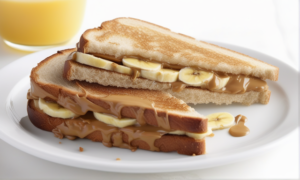 Heart-Healthy Peanut Butter and Banana Breakfast Sandwich
Start your day right with our Heart-Healthy Peanut Butter and Banana Breakfast Sandwich. This quick and easy recipe features the delightful combination of creamy peanut butter and ripe bananas, offering you a delicious and heart-friendly breakfast option.
Ingredients:
2 slices 100% whole wheat with honey bread
4 teaspoons reduced-fat creamy peanut butter
1 very small banana or 1/2 of a medium banana, sliced
Directions:
Toast the whole wheat bread slices. While the toast is still warm, spread 2 teaspoons of reduced-fat creamy peanut butter on each slice.
Arrange the banana slices on one of the slices of peanut butter toast. Top with the other slice, peanut butter side down, to create a wholesome sandwich.
Heart Health Benefits:
Whole Wheat Bread: High in fiber and nutrients, promoting heart health.
Reduced-Fat Peanut Butter: Provides protein and healthy fats for cardiovascular support.
Banana: Rich in potassium, supporting heart function.
Heart-Healthy Peanut Butter and Banana Breakfast Sandwich
Start your day right with our Heart-Healthy Peanut Butter and Banana Breakfast Sandwich. This quick and easy recipe features the delightful combination of creamy peanut butter and ripe bananas, offering you a delicious and heart-friendly breakfast option.
Ingredients:
2 slices 100% whole wheat with honey bread
4 teaspoons reduced-fat creamy peanut butter
1 very small banana or 1/2 of a medium banana, sliced
Directions:
Toast the whole wheat bread slices. While the toast is still warm, spread 2 teaspoons of reduced-fat creamy peanut butter on each slice.
Arrange the banana slices on one of the slices of peanut butter toast. Top with the other slice, peanut butter side down, to create a wholesome sandwich.
Heart Health Benefits:
Whole Wheat Bread: High in fiber and nutrients, promoting heart health.
Reduced-Fat Peanut Butter: Provides protein and healthy fats for cardiovascular support.
Banana: Rich in potassium, supporting heart function.
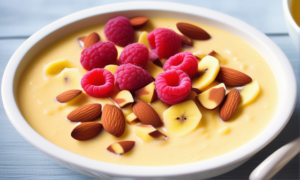 Heart-Boosting Mango-Almond Smoothie Bowl
Indulge in a heart-healthy treat with our Mango-Almond Smoothie Bowl! This delightful and nutritious smoothie bowl combines the tropical goodness of mango, the creaminess of Greek yogurt, and the nutty crunch of almonds. Packed with heart-loving ingredients, it's not only delicious but also beneficial for your cardiovascular well-being.
Ingredients:
½ cup frozen chopped mango
½ cup nonfat plain Greek yogurt
¼ cup frozen sliced banana
¼ cup plain unsweetened almond milk
5 tablespoons unsalted almonds, divided
⅛ teaspoon ground allspice
¼ cup raspberries
½ teaspoon honey
Directions:
Blend mango, yogurt, banana, almond milk, 3 tablespoons almonds, and allspice in a blender until very smooth.
Pour the smoothie into a bowl and top with raspberries, the remaining 2 tablespoons almonds, and a drizzle of honey.
Heart Health Benefits:
Mango: Rich in vitamins and antioxidants for heart support.
Greek Yogurt: Packed with protein and probiotics, promoting heart wellness.
Almonds: Healthy fats, fiber, and nutrients for heart health.
Banana: Potassium and fiber content contribute to heart well-being.
Almond Milk: A dairy-free, heart-healthy alternative.
Raspberries: Antioxidants supporting cardiovascular health.
Heart-Boosting Mango-Almond Smoothie Bowl
Indulge in a heart-healthy treat with our Mango-Almond Smoothie Bowl! This delightful and nutritious smoothie bowl combines the tropical goodness of mango, the creaminess of Greek yogurt, and the nutty crunch of almonds. Packed with heart-loving ingredients, it's not only delicious but also beneficial for your cardiovascular well-being.
Ingredients:
½ cup frozen chopped mango
½ cup nonfat plain Greek yogurt
¼ cup frozen sliced banana
¼ cup plain unsweetened almond milk
5 tablespoons unsalted almonds, divided
⅛ teaspoon ground allspice
¼ cup raspberries
½ teaspoon honey
Directions:
Blend mango, yogurt, banana, almond milk, 3 tablespoons almonds, and allspice in a blender until very smooth.
Pour the smoothie into a bowl and top with raspberries, the remaining 2 tablespoons almonds, and a drizzle of honey.
Heart Health Benefits:
Mango: Rich in vitamins and antioxidants for heart support.
Greek Yogurt: Packed with protein and probiotics, promoting heart wellness.
Almonds: Healthy fats, fiber, and nutrients for heart health.
Banana: Potassium and fiber content contribute to heart well-being.
Almond Milk: A dairy-free, heart-healthy alternative.
Raspberries: Antioxidants supporting cardiovascular health.
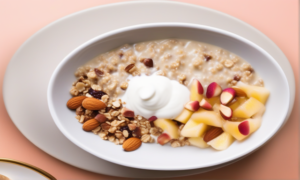 Heart-Boosting Fruit & Nut Oatmeal
Start your day right with a heart-healthy twist to your morning routine! This protein-packed oatmeal recipe not only provides essential nutrients but also adds a touch of sweetness with apples and a satisfying crunch from walnuts. Tailor this wholesome oatmeal by choosing your favorite fruits—berries or pears—and nuts like almonds or pistachios to create a personalized and heart-friendly breakfast.
Ingredients:
½ cup old-fashioned oats
1 cup skim milk
¼ cup nonfat plain Greek yogurt
¼ cup chopped apple
1 tablespoon walnuts, toasted if desired
Directions:
Combine oats and milk in a small saucepan. Bring just to a boil over high heat; then reduce the heat to medium and cook, stirring frequently, until the oats are tender and creamy, 4 to 5 minutes.
Remove from the heat, cover, and let stand for 2 minutes.
Serve topped with yogurt, chopped apple, and walnuts.
Heart Health Benefits:
Oats: High in soluble fiber, promoting heart health.
Skim Milk: Low-fat dairy for essential nutrients without excess saturated fat.
Greek Yogurt: Packed with protein and probiotics for heart wellness.
Apples: Rich in antioxidants and fiber, supporting cardiovascular well-being.
Walnuts: Omega-3 fatty acids for heart health.
Heart-Boosting Fruit & Nut Oatmeal
Start your day right with a heart-healthy twist to your morning routine! This protein-packed oatmeal recipe not only provides essential nutrients but also adds a touch of sweetness with apples and a satisfying crunch from walnuts. Tailor this wholesome oatmeal by choosing your favorite fruits—berries or pears—and nuts like almonds or pistachios to create a personalized and heart-friendly breakfast.
Ingredients:
½ cup old-fashioned oats
1 cup skim milk
¼ cup nonfat plain Greek yogurt
¼ cup chopped apple
1 tablespoon walnuts, toasted if desired
Directions:
Combine oats and milk in a small saucepan. Bring just to a boil over high heat; then reduce the heat to medium and cook, stirring frequently, until the oats are tender and creamy, 4 to 5 minutes.
Remove from the heat, cover, and let stand for 2 minutes.
Serve topped with yogurt, chopped apple, and walnuts.
Heart Health Benefits:
Oats: High in soluble fiber, promoting heart health.
Skim Milk: Low-fat dairy for essential nutrients without excess saturated fat.
Greek Yogurt: Packed with protein and probiotics for heart wellness.
Apples: Rich in antioxidants and fiber, supporting cardiovascular well-being.
Walnuts: Omega-3 fatty acids for heart health.
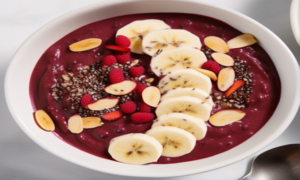 Heart-Boosting Acai Bowl
Kickstart your day with a heart-healthy indulgence! Our homemade Acai Bowl is a delightful breakfast option any day of the week. The natural tartness of acai is perfectly balanced with the sweetness of banana, mixed berries, and coconut water in this nourishing recipe. Topped with a variety of heart-friendly ingredients, this bowl is not only delicious but also loaded with nutrients that support cardiovascular well-being.
Ingredients:
1 banana
½ cup frozen mixed berries
1 (3.5-ounce) package frozen unsweetened acai puree
¼ cup fat-free plain strained yogurt, such as Greek-style
¼ cup coconut water
1 tablespoon almond butter
⅛ teaspoon ground cinnamon
2 tablespoons dried goji berries
2 tablespoons sliced almonds, toasted (see Tip)
1 teaspoon chia seeds
1 teaspoon hemp seeds
Directions:
Cut the banana in half crosswise; peel 1 half (set aside the remaining unpeeled half). Place the peeled banana half on a freezer-safe plate lined with parchment paper; freeze until solid, about 2 hours.
Place the frozen banana, berries, acai puree, yogurt, coconut water, almond butter, and cinnamon in a blender. Blend until smooth, 30 to 45 seconds, stopping to scrape down the sides of the blender as needed. Peel and slice the reserved banana half.
Pour the smoothie into a bowl; top with banana slices, goji berries, almonds, chia seeds, and hemp seeds. Serve immediately.
Heart Health Benefits:
Acai: Packed with antioxidants that support heart health.
Berries: Rich in fiber and vitamins, contributing to cardiovascular wellness.
Coconut Water: Hydrating and beneficial for heart function.
Almond Butter: High in monounsaturated fats, promoting heart wellness.
Chia Seeds and Hemp Seeds: Omega-3 fatty acids for heart health.
Heart-Boosting Acai Bowl
Kickstart your day with a heart-healthy indulgence! Our homemade Acai Bowl is a delightful breakfast option any day of the week. The natural tartness of acai is perfectly balanced with the sweetness of banana, mixed berries, and coconut water in this nourishing recipe. Topped with a variety of heart-friendly ingredients, this bowl is not only delicious but also loaded with nutrients that support cardiovascular well-being.
Ingredients:
1 banana
½ cup frozen mixed berries
1 (3.5-ounce) package frozen unsweetened acai puree
¼ cup fat-free plain strained yogurt, such as Greek-style
¼ cup coconut water
1 tablespoon almond butter
⅛ teaspoon ground cinnamon
2 tablespoons dried goji berries
2 tablespoons sliced almonds, toasted (see Tip)
1 teaspoon chia seeds
1 teaspoon hemp seeds
Directions:
Cut the banana in half crosswise; peel 1 half (set aside the remaining unpeeled half). Place the peeled banana half on a freezer-safe plate lined with parchment paper; freeze until solid, about 2 hours.
Place the frozen banana, berries, acai puree, yogurt, coconut water, almond butter, and cinnamon in a blender. Blend until smooth, 30 to 45 seconds, stopping to scrape down the sides of the blender as needed. Peel and slice the reserved banana half.
Pour the smoothie into a bowl; top with banana slices, goji berries, almonds, chia seeds, and hemp seeds. Serve immediately.
Heart Health Benefits:
Acai: Packed with antioxidants that support heart health.
Berries: Rich in fiber and vitamins, contributing to cardiovascular wellness.
Coconut Water: Hydrating and beneficial for heart function.
Almond Butter: High in monounsaturated fats, promoting heart wellness.
Chia Seeds and Hemp Seeds: Omega-3 fatty acids for heart health.
Classics Games
Hot Recipes
Latest Lists
 Farro Salad with Arugula, Artichokes & Pistachios
Experience the ease and deliciousness of this farro salad, made effortlessly with precooked farro. The best part? You can prepare and serve it in the same bowl, keeping cleanup to a minimum!
Ingredients:
1 tablespoon lemon juice
1 tablespoon extra-virgin olive oil
¾ cup cooked farro
1 ½ cups packed baby arugula
¼ cup packed small fresh mint leaves
2 tablespoons thinly sliced fresh basil
1 canned whole artichoke heart (or 4 quarters), rinsed and chopped
⅛ teaspoon salt
2 tablespoons chopped salted dry-roasted pistachios
1 ½ tablespoons pomegranate seeds (arils) or dried cranberries
¾ ounce soft goat cheese, crumbled (2 tablespoons)
Directions:
Whisk lemon juice and oil in a salad bowl.
Stir in farro, arugula, mint, basil, artichoke, and salt.
Sprinkle with pistachios, pomegranate seeds, and goat cheese.
Benefits for Diabetes:This farro salad is a diabetes-friendly choice due to its low glycemic index. Farro provides complex carbohydrates, which are slowly absorbed, helping manage blood sugar levels. Additionally, the inclusion of arugula and other fresh herbs brings in essential nutrients without spiking blood sugar. The healthy fats from olive oil and the crunch of pistachios add flavor and satiety, making it a well-balanced option for individuals with diabetes.
Farro Salad with Arugula, Artichokes & Pistachios
Experience the ease and deliciousness of this farro salad, made effortlessly with precooked farro. The best part? You can prepare and serve it in the same bowl, keeping cleanup to a minimum!
Ingredients:
1 tablespoon lemon juice
1 tablespoon extra-virgin olive oil
¾ cup cooked farro
1 ½ cups packed baby arugula
¼ cup packed small fresh mint leaves
2 tablespoons thinly sliced fresh basil
1 canned whole artichoke heart (or 4 quarters), rinsed and chopped
⅛ teaspoon salt
2 tablespoons chopped salted dry-roasted pistachios
1 ½ tablespoons pomegranate seeds (arils) or dried cranberries
¾ ounce soft goat cheese, crumbled (2 tablespoons)
Directions:
Whisk lemon juice and oil in a salad bowl.
Stir in farro, arugula, mint, basil, artichoke, and salt.
Sprinkle with pistachios, pomegranate seeds, and goat cheese.
Benefits for Diabetes:This farro salad is a diabetes-friendly choice due to its low glycemic index. Farro provides complex carbohydrates, which are slowly absorbed, helping manage blood sugar levels. Additionally, the inclusion of arugula and other fresh herbs brings in essential nutrients without spiking blood sugar. The healthy fats from olive oil and the crunch of pistachios add flavor and satiety, making it a well-balanced option for individuals with diabetes.
 Sesame Kohlrabi & Chicken Salad Recipe
Experience a delightful blend of flavors and textures with our Sesame Kohlrabi & Chicken Salad. Kohlrabi, a bulbous vegetable with a sweet, mild taste, combines harmoniously with almonds to bring a satisfying crunch to this crowd-pleaser. For a versatile twist, you can substitute chicken with baked tofu or shrimp.
Ingredients:
¼ cup rice vinegar
3 tablespoons 50%-less-sodium tamari
1 tablespoon chile-garlic sauce
1 tablespoon grated orange zest
½ cup finely chopped fresh cilantro, divided
2 tablespoons grapeseed or canola oil
2 tablespoons toasted sesame oil
1 large kohlrabi (about 1 pound), peeled and cut into matchsticks
3 cups shredded napa cabbage
3 cups shredded cooked chicken
1 cup grated carrots
1 cup thinly sliced snow peas
¼ cup sliced almonds, toasted
1 tablespoon sesame seeds, toasted
Directions:
In a large bowl, whisk together rice vinegar, tamari, chile-garlic sauce, orange zest, and ¼ cup of cilantro.
Slowly whisk in grapeseed (or canola) oil and toasted sesame oil.
Stir in kohlrabi, napa cabbage, cooked chicken, grated carrots, and snow peas.
Serve the salad topped with toasted almonds, sesame seeds, and the remaining 1/4 cup of cilantro.
Why It's Beneficial for Diabetics:This Sesame Kohlrabi & Chicken Salad is not only a flavorful delight but also a diabetes-friendly option. The inclusion of kohlrabi, a low-carb vegetable, helps regulate blood sugar levels. Additionally, the nutrient-rich ingredients, such as cabbage, chicken, and almonds, contribute to a balanced and diabetes-conscious meal. The salad's vibrant mix of flavors ensures a satisfying experience without compromising health, making it an excellent choice for individuals managing diabetes.
Sesame Kohlrabi & Chicken Salad Recipe
Experience a delightful blend of flavors and textures with our Sesame Kohlrabi & Chicken Salad. Kohlrabi, a bulbous vegetable with a sweet, mild taste, combines harmoniously with almonds to bring a satisfying crunch to this crowd-pleaser. For a versatile twist, you can substitute chicken with baked tofu or shrimp.
Ingredients:
¼ cup rice vinegar
3 tablespoons 50%-less-sodium tamari
1 tablespoon chile-garlic sauce
1 tablespoon grated orange zest
½ cup finely chopped fresh cilantro, divided
2 tablespoons grapeseed or canola oil
2 tablespoons toasted sesame oil
1 large kohlrabi (about 1 pound), peeled and cut into matchsticks
3 cups shredded napa cabbage
3 cups shredded cooked chicken
1 cup grated carrots
1 cup thinly sliced snow peas
¼ cup sliced almonds, toasted
1 tablespoon sesame seeds, toasted
Directions:
In a large bowl, whisk together rice vinegar, tamari, chile-garlic sauce, orange zest, and ¼ cup of cilantro.
Slowly whisk in grapeseed (or canola) oil and toasted sesame oil.
Stir in kohlrabi, napa cabbage, cooked chicken, grated carrots, and snow peas.
Serve the salad topped with toasted almonds, sesame seeds, and the remaining 1/4 cup of cilantro.
Why It's Beneficial for Diabetics:This Sesame Kohlrabi & Chicken Salad is not only a flavorful delight but also a diabetes-friendly option. The inclusion of kohlrabi, a low-carb vegetable, helps regulate blood sugar levels. Additionally, the nutrient-rich ingredients, such as cabbage, chicken, and almonds, contribute to a balanced and diabetes-conscious meal. The salad's vibrant mix of flavors ensures a satisfying experience without compromising health, making it an excellent choice for individuals managing diabetes.
 Unlock the Heart-Health Secrets: 10 Nutrient-Rich Breakfasts
Embark on a journey of heart-healthy mornings with these ten delightful and nutritious breakfast recipes. Nourish your heart and kickstart your day with a blend of flavors, nutrients, and wholesome ingredients.
1. Breakfast Beans with Microwave-Poached Egg
Indulge in the Gallo Pinto Delight, inspired by Costa Rican traditions. This savory blend of beans, barley, and a poached egg offers a protein-packed and satisfying start to your day.
View Recipe
2. Pineapple-Grapefruit Detox Smoothie
Revitalize your mornings with a burst of freshness. This detox smoothie, featuring pineapple, grapefruit, and spinach, not only hydrates but also provides a bounty of fiber for a heart-healthy kick.
View Recipe
3. Spinach & Egg Scramble with Raspberries
Fuel your body with a nutrient-rich scramble. The combination of protein-packed eggs, superfood raspberries, and nutrient-rich spinach creates a breakfast that supports your heart while keeping you full.
View Recipe
4. Everything Bagel Avocado Toast
Experience the marriage of everything bagel flavor and creamy avocado toast. This quick and easy breakfast combines taste with heart-healthy fats for a satisfying morning treat.
View Recipe
5. Heart-Healthy Two-Ingredient Banana Pancakes
Savor the simplicity of two-ingredient banana pancakes. With just eggs and banana, indulge in a grain-free and sugar-free pancake option that promotes heart health.
View Recipe
6. Heart-Healthy Peanut Butter and Banana Breakfast Sandwich:Combine the classic pairing of peanut butter and banana in a wholesome breakfast sandwich. Packed with protein and potassium, this sandwich is a heart-smart choice.
View Recipe
7. Heart-Boosting Mango-Almond Smoothie Bowl:Indulge in a vibrant smoothie bowl featuring mango and almonds. Rich in vitamins, minerals, and heart-healthy fats, this bowl is a delicious way to nourish your heart.
View Recipe
8. Heart-Boosting Fruit & Nut Oatmeal:Kickstart your day with a hearty bowl of oatmeal loaded with fruits and nuts. Oats are known to promote heart health, making this breakfast a comforting and nutritious choice.
View Recipe
9. Heart-Boosting Acai Bowl:Fuel your body with antioxidants and heart-healthy nutrients with acai bowl topped with a medley of fruits and nuts. A delicious and visually appealing breakfast for your heart.
View Recipe
10. Heart-Boosting Peanut Butter-Banana English Muffin:Savor the goodness of peanut butter and banana on a whole-grain English muffin. Quick, easy, and heart-boosting, this breakfast is perfect for those busy mornings.
View Recipe
Elevate your breakfast routine with these heart-healthy recipes and make each morning a step towards a healthier heart.
Unlock the Heart-Health Secrets: 10 Nutrient-Rich Breakfasts
Embark on a journey of heart-healthy mornings with these ten delightful and nutritious breakfast recipes. Nourish your heart and kickstart your day with a blend of flavors, nutrients, and wholesome ingredients.
1. Breakfast Beans with Microwave-Poached Egg
Indulge in the Gallo Pinto Delight, inspired by Costa Rican traditions. This savory blend of beans, barley, and a poached egg offers a protein-packed and satisfying start to your day.
View Recipe
2. Pineapple-Grapefruit Detox Smoothie
Revitalize your mornings with a burst of freshness. This detox smoothie, featuring pineapple, grapefruit, and spinach, not only hydrates but also provides a bounty of fiber for a heart-healthy kick.
View Recipe
3. Spinach & Egg Scramble with Raspberries
Fuel your body with a nutrient-rich scramble. The combination of protein-packed eggs, superfood raspberries, and nutrient-rich spinach creates a breakfast that supports your heart while keeping you full.
View Recipe
4. Everything Bagel Avocado Toast
Experience the marriage of everything bagel flavor and creamy avocado toast. This quick and easy breakfast combines taste with heart-healthy fats for a satisfying morning treat.
View Recipe
5. Heart-Healthy Two-Ingredient Banana Pancakes
Savor the simplicity of two-ingredient banana pancakes. With just eggs and banana, indulge in a grain-free and sugar-free pancake option that promotes heart health.
View Recipe
6. Heart-Healthy Peanut Butter and Banana Breakfast Sandwich:Combine the classic pairing of peanut butter and banana in a wholesome breakfast sandwich. Packed with protein and potassium, this sandwich is a heart-smart choice.
View Recipe
7. Heart-Boosting Mango-Almond Smoothie Bowl:Indulge in a vibrant smoothie bowl featuring mango and almonds. Rich in vitamins, minerals, and heart-healthy fats, this bowl is a delicious way to nourish your heart.
View Recipe
8. Heart-Boosting Fruit & Nut Oatmeal:Kickstart your day with a hearty bowl of oatmeal loaded with fruits and nuts. Oats are known to promote heart health, making this breakfast a comforting and nutritious choice.
View Recipe
9. Heart-Boosting Acai Bowl:Fuel your body with antioxidants and heart-healthy nutrients with acai bowl topped with a medley of fruits and nuts. A delicious and visually appealing breakfast for your heart.
View Recipe
10. Heart-Boosting Peanut Butter-Banana English Muffin:Savor the goodness of peanut butter and banana on a whole-grain English muffin. Quick, easy, and heart-boosting, this breakfast is perfect for those busy mornings.
View Recipe
Elevate your breakfast routine with these heart-healthy recipes and make each morning a step towards a healthier heart.
 Breakfast Beans with Microwave-Poached Egg
Gallo Pinto Delight: A Flavorful Costa Rican Breakfast
Recipe:
Indulge in the savory goodness of Breakfast Beans with Microwave-Poached Egg, inspired by the Costa Rican classic, Gallo Pinto. The term translates to "spotted rooster," reflecting the dark beans amid the pale rice. While the traditional dish uses rice, our version features cooked barley for a nutritious twist. Feel free to substitute with any leftover cooked grain you have on hand.
Ingredients:
2 teaspoons canola oil
¼ cup chopped red bell pepper
2 chopped scallions, whites and greens separated
½ teaspoon ground cumin
¾ cup rinsed canned low-sodium black beans
½ cup cooked barley
½ cup low-sodium chicken broth or vegetable broth
⅛ teaspoon salt
⅛ teaspoon hot sauce
1 cup water, divided
1 teaspoon distilled white vinegar, divided
2 large eggs, divided
2 tablespoons shredded pepper Jack cheese
½ avocado, sliced
2 tablespoons coarsely chopped fresh cilantro
Directions:
Heat oil in a medium skillet; add bell pepper, scallion whites, and cumin. Cook until softened, stirring often (1 to 2 minutes).
Add black beans, cooked barley, broth, and salt. Cook until most liquid is absorbed (3 to 5 minutes). Stir in scallion greens and hot sauce. Divide between 2 bowls.
In a microwave-safe bowl, combine 1/2 cup water and 1/2 tsp. vinegar. Carefully crack 1 egg into the water, ensuring it's completely submerged. Microwave until the egg white is firm and the yolk is slightly runny (about 1 minute).
Remove the egg, pat dry, and place atop the bean mixture in one bowl. Repeat with the remaining water, vinegar, and egg.
Top each bowl with 1 Tbsp. cheese and 1/4 avocado. Sprinkle with cilantro if desired.
Breakfast Beans with Microwave-Poached Egg
Gallo Pinto Delight: A Flavorful Costa Rican Breakfast
Recipe:
Indulge in the savory goodness of Breakfast Beans with Microwave-Poached Egg, inspired by the Costa Rican classic, Gallo Pinto. The term translates to "spotted rooster," reflecting the dark beans amid the pale rice. While the traditional dish uses rice, our version features cooked barley for a nutritious twist. Feel free to substitute with any leftover cooked grain you have on hand.
Ingredients:
2 teaspoons canola oil
¼ cup chopped red bell pepper
2 chopped scallions, whites and greens separated
½ teaspoon ground cumin
¾ cup rinsed canned low-sodium black beans
½ cup cooked barley
½ cup low-sodium chicken broth or vegetable broth
⅛ teaspoon salt
⅛ teaspoon hot sauce
1 cup water, divided
1 teaspoon distilled white vinegar, divided
2 large eggs, divided
2 tablespoons shredded pepper Jack cheese
½ avocado, sliced
2 tablespoons coarsely chopped fresh cilantro
Directions:
Heat oil in a medium skillet; add bell pepper, scallion whites, and cumin. Cook until softened, stirring often (1 to 2 minutes).
Add black beans, cooked barley, broth, and salt. Cook until most liquid is absorbed (3 to 5 minutes). Stir in scallion greens and hot sauce. Divide between 2 bowls.
In a microwave-safe bowl, combine 1/2 cup water and 1/2 tsp. vinegar. Carefully crack 1 egg into the water, ensuring it's completely submerged. Microwave until the egg white is firm and the yolk is slightly runny (about 1 minute).
Remove the egg, pat dry, and place atop the bean mixture in one bowl. Repeat with the remaining water, vinegar, and egg.
Top each bowl with 1 Tbsp. cheese and 1/4 avocado. Sprinkle with cilantro if desired.
 Pineapple-Grapefruit Detox Smoothie
Heart-Healthy Hydration Boost
Recipe:
Indulge in the refreshing Pineapple-Grapefruit Detox Smoothie, crafted with hydrating pineapple, grapefruit, and nutrient-packed spinach. This delightful blend not only quenches your thirst but also provides a bounty of fiber. The addition of electrolyte-rich coconut water serves as a dairy-free alternative, contributing to the smoothie's heart-healthy profile. For an extra-chilled experience, freeze coconut water into cubes before blending.
Ingredients:
1 cup plain coconut water
1 cup frozen diced pineapple
1 cup packed baby spinach
1 small grapefruit, peeled and segmented, plus any juice squeezed from the membranes
½ teaspoon grated fresh ginger
1 cup ice
Directions:
Combine coconut water, frozen pineapple, baby spinach, peeled and segmented grapefruit, ginger, and ice in a blender.
Puree the ingredients until smooth and frothy.
Heart Benefits:
This detox smoothie is not just a flavorful treat; it's also heart-friendly. The combination of pineapple, grapefruit, and spinach delivers essential minerals and fiber, promoting hydration and cardiovascular health. Coconut water adds electrolytes, making it a nourishing option for your heart.
Pineapple-Grapefruit Detox Smoothie
Heart-Healthy Hydration Boost
Recipe:
Indulge in the refreshing Pineapple-Grapefruit Detox Smoothie, crafted with hydrating pineapple, grapefruit, and nutrient-packed spinach. This delightful blend not only quenches your thirst but also provides a bounty of fiber. The addition of electrolyte-rich coconut water serves as a dairy-free alternative, contributing to the smoothie's heart-healthy profile. For an extra-chilled experience, freeze coconut water into cubes before blending.
Ingredients:
1 cup plain coconut water
1 cup frozen diced pineapple
1 cup packed baby spinach
1 small grapefruit, peeled and segmented, plus any juice squeezed from the membranes
½ teaspoon grated fresh ginger
1 cup ice
Directions:
Combine coconut water, frozen pineapple, baby spinach, peeled and segmented grapefruit, ginger, and ice in a blender.
Puree the ingredients until smooth and frothy.
Heart Benefits:
This detox smoothie is not just a flavorful treat; it's also heart-friendly. The combination of pineapple, grapefruit, and spinach delivers essential minerals and fiber, promoting hydration and cardiovascular health. Coconut water adds electrolytes, making it a nourishing option for your heart.
 Spinach & Egg Scramble with Raspberries
Heart-Healthy Breakfast for Weight Loss
Recipe:
Indulge in a quick and nutritious egg scramble paired with wholesome bread, creating one of the best breakfasts for weight loss. This delightful dish combines protein-packed eggs, antioxidant-rich raspberries, filling whole-grain toast, and nutrient-packed spinach. The perfect blend of protein and fiber will keep you satisfied and energized throughout the morning.
Ingredients:
1 teaspoon canola oil
1 ½ cups baby spinach (1 1/2 ounces)
2 large eggs, lightly beaten
Pinch of kosher salt
Pinch of ground pepper
1 slice whole-grain bread, toasted
½ cup fresh raspberries
Directions:
Heat canola oil in a small nonstick skillet over medium-high heat.
Add spinach and cook until wilted, stirring often, 1 to 2 minutes. Transfer the spinach to a plate.
Wipe the pan clean, place over medium heat, and add lightly beaten eggs. Cook, stirring once or twice for even cooking, until just set, 1 to 2 minutes.
Stir in the cooked spinach, kosher salt, and ground pepper.
Serve the delightful scramble with toasted whole-grain bread and a side of fresh raspberries.
Heart Benefits:
The combination of nutrient-rich spinach and antioxidant-loaded raspberries contributes to heart health. The inclusion of whole-grain toast adds fiber, making this breakfast not only delicious but also beneficial for your cardiovascular well-being.
Spinach & Egg Scramble with Raspberries
Heart-Healthy Breakfast for Weight Loss
Recipe:
Indulge in a quick and nutritious egg scramble paired with wholesome bread, creating one of the best breakfasts for weight loss. This delightful dish combines protein-packed eggs, antioxidant-rich raspberries, filling whole-grain toast, and nutrient-packed spinach. The perfect blend of protein and fiber will keep you satisfied and energized throughout the morning.
Ingredients:
1 teaspoon canola oil
1 ½ cups baby spinach (1 1/2 ounces)
2 large eggs, lightly beaten
Pinch of kosher salt
Pinch of ground pepper
1 slice whole-grain bread, toasted
½ cup fresh raspberries
Directions:
Heat canola oil in a small nonstick skillet over medium-high heat.
Add spinach and cook until wilted, stirring often, 1 to 2 minutes. Transfer the spinach to a plate.
Wipe the pan clean, place over medium heat, and add lightly beaten eggs. Cook, stirring once or twice for even cooking, until just set, 1 to 2 minutes.
Stir in the cooked spinach, kosher salt, and ground pepper.
Serve the delightful scramble with toasted whole-grain bread and a side of fresh raspberries.
Heart Benefits:
The combination of nutrient-rich spinach and antioxidant-loaded raspberries contributes to heart health. The inclusion of whole-grain toast adds fiber, making this breakfast not only delicious but also beneficial for your cardiovascular well-being.
 Everything Bagel Avocado Toast
Recipe:
Indulge in the perfect union of everything bagel flavor and the creamy goodness of avocado toast with this quick and healthy breakfast. Ideal for those busy mornings when you're on the go. Elevate it further by adding a poached or fried egg on top.
Ingredients:
¼ medium avocado, mashed
1 slice whole-grain bread, toasted
2 teaspoons everything bagel seasoning
Pinch of flaky sea salt (such as Maldon)
Directions:
Spread mashed avocado on the toasted bread.
Sprinkle with everything bagel seasoning.
Add a pinch of flaky sea salt.
Optional: Top with a poached or fried egg for an extra savory twist.
Everything Bagel Avocado Toast
Recipe:
Indulge in the perfect union of everything bagel flavor and the creamy goodness of avocado toast with this quick and healthy breakfast. Ideal for those busy mornings when you're on the go. Elevate it further by adding a poached or fried egg on top.
Ingredients:
¼ medium avocado, mashed
1 slice whole-grain bread, toasted
2 teaspoons everything bagel seasoning
Pinch of flaky sea salt (such as Maldon)
Directions:
Spread mashed avocado on the toasted bread.
Sprinkle with everything bagel seasoning.
Add a pinch of flaky sea salt.
Optional: Top with a poached or fried egg for an extra savory twist.
 Heart-Healthy Two-Ingredient Banana Pancakes
Indulge in the simplicity and delightful taste of these two-ingredient banana pancakes, perfect for a healthy breakfast. Prepared with just eggs and bananas, these pancakes are not only grain-free but also free from added sugars.
Ingredients:
2 large eggs
1 medium banana
Instructions:
In a blender, combine the eggs and banana, blending until you achieve a smooth puree.
Lightly oil a spacious nonstick skillet (refer to Tip) and heat it over medium heat.
Spoon 2 tablespoons of batter for each pancake, creating 4 mounds in the pan.
Cook until bubbles emerge on the surface, and the edges appear dry, typically taking 2 to 4 minutes.
Gently flip the pancakes using a thin spatula and cook until the bottom is nicely browned, around 1 to 2 minutes more.
Transfer the golden pancakes to a plate.
Lightly oil the pan once more and repeat the cooking process with the remaining batter.
Heart-Healthy Note:
These two-ingredient banana pancakes not only satisfy your taste buds but also contribute to heart health. Bananas are rich in potassium, an essential mineral that aids in maintaining proper heart function and blood pressure. Additionally, the absence of added sugars in this recipe aligns with heart-friendly dietary choices, promoting overall cardiovascular well-being. Enjoy these pancakes as a nutritious and heart-conscious breakfast option.
Tip: Use a nonstick skillet to minimize the need for excessive oil, ensuring a healthier cooking process.
Heart-Healthy Two-Ingredient Banana Pancakes
Indulge in the simplicity and delightful taste of these two-ingredient banana pancakes, perfect for a healthy breakfast. Prepared with just eggs and bananas, these pancakes are not only grain-free but also free from added sugars.
Ingredients:
2 large eggs
1 medium banana
Instructions:
In a blender, combine the eggs and banana, blending until you achieve a smooth puree.
Lightly oil a spacious nonstick skillet (refer to Tip) and heat it over medium heat.
Spoon 2 tablespoons of batter for each pancake, creating 4 mounds in the pan.
Cook until bubbles emerge on the surface, and the edges appear dry, typically taking 2 to 4 minutes.
Gently flip the pancakes using a thin spatula and cook until the bottom is nicely browned, around 1 to 2 minutes more.
Transfer the golden pancakes to a plate.
Lightly oil the pan once more and repeat the cooking process with the remaining batter.
Heart-Healthy Note:
These two-ingredient banana pancakes not only satisfy your taste buds but also contribute to heart health. Bananas are rich in potassium, an essential mineral that aids in maintaining proper heart function and blood pressure. Additionally, the absence of added sugars in this recipe aligns with heart-friendly dietary choices, promoting overall cardiovascular well-being. Enjoy these pancakes as a nutritious and heart-conscious breakfast option.
Tip: Use a nonstick skillet to minimize the need for excessive oil, ensuring a healthier cooking process.
 12 Snacks Suitable for Diabetics, Recommended for Regular Stocking at Home
Diabetes patients need to maintain a sense of fullness to avoid low blood sugar and overeating. Here are 12 snacks with strong satiety, minimal impact on blood sugar, and recommended for storage.
1. Tofu Jerky
Rich in nutrients, containing high-quality protein and calcium.
Natural functional ingredients like soy dietary fiber, soy isoflavones, and soy oligosaccharides slow down glucose absorption.
Snack: Not exceeding 100 grams, choose low-salt, sugar-free tofu jerky.
2. Boiled Chickpeas
Known as the "king of beans," rich in high-quality protein and dietary fiber.
Low glycemic index (GI=36), low in calories, and provides strong satiety.
Snack: Not exceeding 50 chickpeas.
3. Boiled Eggs
High satiety, rich in protein.
Preferably boiled for 7 minutes until the yolk is nearly fully solidified for optimal nutritional value.
Snack: 1 egg.
4. Tomatoes
Low energy, slow glycemic impact, rich in vitamin C and lycopene.
Snack: 1 large tomato or 15-20 cherry tomatoes.
5. Apples
Contains polyphenols for stable blood sugar.
Rich in dietary fiber, beneficial for preventing heart disease and constipation.
Snack: One fist-sized apple, preferably Fuji apples for higher sweetness.
6. Cucumber
Low calorie, high in dietary fiber, slow glycemic impact.
Suitable for all blood sugar levels.
Snack: 1 cucumber.
7. Grapefruit
Low-calorie, slow glycemic impact, rich in various nutrients.
Suitable for diabetics and those aiming for weight loss.
Snack: 1-2 segments, each about 100 grams.
8. Beef Jerky
Rich in protein and heme iron.
Homemade is preferred to avoid added sugar and salt.
Snack: 3-4 pieces, each about 15 grams.
9. Soda Crackers
Suitable for diabetics with fewer additives.
Snack: Not exceeding 4 pieces.
10. Whole Wheat Bread
Choose rye or whole wheat bread for better postprandial blood sugar control.
Read food labels, snack: about 1 slice, not exceeding 150 calories.
11. Milk or Yogurt
Milk is rich in protein and calcium, aiding in stabilizing blood sugar.
Yogurt is a quality snack; check protein and carbohydrate content.
Snack: 1 cup, about 250 ml, choose plain milk or yogurt.
12. Plain Nuts
Rich in unsaturated fatty acids, protein, vitamins, minerals, and dietary fiber.
Moderate consumption helps prevent atherosclerosis.
Weekly intake: 50-70 grams, Snack: 2 walnuts, 15 almonds, 4 hazelnuts, 30 plain pistachios, or 15-18 peanuts each time.
Note: Daily snack intake should be around 1/10 of the total daily energy intake, equivalent to 1 fist-sized apple + 100 grams of plain yogurt + 2 walnuts.
12 Snacks Suitable for Diabetics, Recommended for Regular Stocking at Home
Diabetes patients need to maintain a sense of fullness to avoid low blood sugar and overeating. Here are 12 snacks with strong satiety, minimal impact on blood sugar, and recommended for storage.
1. Tofu Jerky
Rich in nutrients, containing high-quality protein and calcium.
Natural functional ingredients like soy dietary fiber, soy isoflavones, and soy oligosaccharides slow down glucose absorption.
Snack: Not exceeding 100 grams, choose low-salt, sugar-free tofu jerky.
2. Boiled Chickpeas
Known as the "king of beans," rich in high-quality protein and dietary fiber.
Low glycemic index (GI=36), low in calories, and provides strong satiety.
Snack: Not exceeding 50 chickpeas.
3. Boiled Eggs
High satiety, rich in protein.
Preferably boiled for 7 minutes until the yolk is nearly fully solidified for optimal nutritional value.
Snack: 1 egg.
4. Tomatoes
Low energy, slow glycemic impact, rich in vitamin C and lycopene.
Snack: 1 large tomato or 15-20 cherry tomatoes.
5. Apples
Contains polyphenols for stable blood sugar.
Rich in dietary fiber, beneficial for preventing heart disease and constipation.
Snack: One fist-sized apple, preferably Fuji apples for higher sweetness.
6. Cucumber
Low calorie, high in dietary fiber, slow glycemic impact.
Suitable for all blood sugar levels.
Snack: 1 cucumber.
7. Grapefruit
Low-calorie, slow glycemic impact, rich in various nutrients.
Suitable for diabetics and those aiming for weight loss.
Snack: 1-2 segments, each about 100 grams.
8. Beef Jerky
Rich in protein and heme iron.
Homemade is preferred to avoid added sugar and salt.
Snack: 3-4 pieces, each about 15 grams.
9. Soda Crackers
Suitable for diabetics with fewer additives.
Snack: Not exceeding 4 pieces.
10. Whole Wheat Bread
Choose rye or whole wheat bread for better postprandial blood sugar control.
Read food labels, snack: about 1 slice, not exceeding 150 calories.
11. Milk or Yogurt
Milk is rich in protein and calcium, aiding in stabilizing blood sugar.
Yogurt is a quality snack; check protein and carbohydrate content.
Snack: 1 cup, about 250 ml, choose plain milk or yogurt.
12. Plain Nuts
Rich in unsaturated fatty acids, protein, vitamins, minerals, and dietary fiber.
Moderate consumption helps prevent atherosclerosis.
Weekly intake: 50-70 grams, Snack: 2 walnuts, 15 almonds, 4 hazelnuts, 30 plain pistachios, or 15-18 peanuts each time.
Note: Daily snack intake should be around 1/10 of the total daily energy intake, equivalent to 1 fist-sized apple + 100 grams of plain yogurt + 2 walnuts.
 Unraveling the Myth: Is Garlic Detrimental for Diabetes? Doctor's Advice on 4 Foods to Limit for Blood Sugar Control
Introduction:Diabetes, a chronic metabolic disorder with an elusive origin, has emerged as a global health concern. According to statistics from the International Diabetes Federation, the global diabetic population has reached a staggering 425 million, with over 150 million in China alone. Maintaining elevated blood sugar levels not only affects vital organs like the brain, heart, blood vessels, kidneys, and liver but can also lead to abnormalities in various bodily systems.
While diabetes itself isn't terrifying, the potential complications it triggers can significantly compromise overall health. For individuals with diabetes, dietary choices play a pivotal role, requiring careful attention to blood sugar control. There's a common belief that garlic is a diabetes "trigger," allegedly causing the onset of diabetes. But is there any scientific basis for this claim?
Factors Contributing to the Rising Diabetes Cases:
Unhealthy Lifestyle:Modern sedentary lifestyles, high-sugar, high-fat diets, lack of exercise, and chronic stress contribute to widespread obesity, increasing the risk of diabetes.
Genetic Factors:Diabetes has a substantial genetic component. A family history of diabetes elevates the risk of developing the condition.
Aging Population:Advances in medical technology leading to longer lifespans contribute to an aging population, increasing the risk of diabetes in older individuals.
Environmental Factors:Environmental pollution, exposure to chemicals, and changes in dietary patterns also impact the risk of developing diabetes.
Common Symptoms of Diabetes:
Polydipsia (Increased Thirst):Elevated blood sugar stimulates the thirst center, leading to increased water intake due to excessive urination and fluid loss.
Polyuria (Frequent Urination):Excessive and frequent urination is a hallmark symptom of diabetes.
Polyphagia (Excessive Hunger):Inadequate utilization of glucose causes hunger, stimulating overeating.
Weight Loss:Insufficient glucose utilization prompts the body to break down fats and proteins, leading to weight loss.
Fatigue:Reduced energy supply due to poor glucose utilization results in fatigue.
Blurred Vision:Changes in eye lens osmolarity due to elevated blood sugar levels can cause blurred vision.
Hazards of Poor Blood Sugar Control:
Cardiovascular Diseases:Prolonged high blood sugar damages endothelial cells, increasing the risk of cardiovascular diseases.
Renal Damage:Long-term elevated blood sugar burdens the kidneys, causing structural and functional changes, eventually leading to kidney failure.
Retinal Changes:Persistent high blood sugar induces retinal vascular changes, leading to serious consequences like visual impairment and blindness.
Neuropathy:Long-term high blood sugar damages nerve cells, causing symptoms like numbness, pain, and sensory abnormalities, potentially leading to amputation.
Increased Infection Risk:High blood sugar promotes bacterial growth, increasing the risk of infections in the skin, urinary tract, respiratory tract, and more.
Compromised Immune Function:Prolonged high blood sugar impairs immune cells, reducing the body's resistance to infections and making disease control challenging.
Debunking the Myth: Garlic as a Diabetes Trigger:Contrary to the misconception that garlic is a diabetes trigger, this belief lacks scientific merit. While garlic contains allicin, providing a spicy sensation, it overlooks the potential benefits for individuals with diabetes. Garlic is not only safe but offers unique nutritional value.
Nutrient-Rich:Garlic is a nutritionally rich ingredient, containing proteins, minerals, and other elements beneficial for overall health. Regular consumption may contribute to anti-aging, improved immunity, and cardiovascular health.
Blood Circulation and Complication Prevention:Moderate consumption of garlic by individuals with diabetes can promote blood circulation and help prevent complications. Certain components in garlic stimulate insulin secretion, aiding tissue cells in utilizing glucose and stabilizing blood sugar levels.
However, moderation is key, as excessive garlic intake may cause discomfort for some individuals.
Doctor's Advice: Limit These 4 Foods to Avoid Blood Sugar Spikes:
Sugarcane:As a high-sugar fruit, sugarcane should be avoided or consumed sparingly by individuals with diabetes. Excessive sugar intake can rapidly elevate blood sugar levels, exacerbating the burden on the pancreas and worsening the condition.
Glutinous Rice (Sticky Rice):With a high glycemic index, glutinous rice poses a disadvantage for individuals with diabetes. Its rapid conversion to glucose during digestion can lead to swift blood sugar spikes, potentially worsening the condition.
Melon Seeds:While rich in nutrients like protein, vitamin E, and minerals, melon seeds are also high in sugar. Excessive consumption can contribute to elevated blood sugar levels, posing a risk to the health of individuals with diabetes.
Red Dates (Jujube):Despite being considered a health food, red dates have a remarkably high sugar content of around 60%. For individuals with diabetes, avoiding high-sugar foods is crucial to prevent sharp increases in blood sugar levels.
Strategies to Improve Diabetes: Know These 4 Methods!
Healthy Eating:Opt for low-sugar, low-fat foods, increase intake of vegetables, fruits, whole grains, and healthy proteins. Control the intake of carbohydrates and saturated fats, avoiding high-sugar, high-salt, and high-fat foods.
Exercise:Engage in appropriate aerobic exercise and strength training based on individual capabilities. Aim for at least 150 minutes of moderate-intensity aerobic activity per week, such as brisk walking, swimming, or cycling, along with full-body muscle exercises.
Weight Management:Maintaining an appropriate weight is crucial for blood sugar control. For those with overweight or obesity, weight reduction through dietary adjustments and increased physical activity improves insulin sensitivity and lowers blood sugar and cholesterol levels.
Regular Monitoring and Treatment:Regularly monitor blood sugar levels, follow prescribed medication plans, and adhere to medical advice. Correct use of oral medications or insulin injections helps ensure blood sugar levels are well-controlled.
Identifying Diabetes-Friendly Foods: 4 Choices to Keep Blood Sugar Stable
Sweet Potatoes:Rich in fiber and vitamins, sweet potatoes have a low glycemic index, providing energy without causing rapid blood sugar spikes.
Black Beans:High in fiber and protein, black beans aid in controlling blood sugar, slowing down the absorption of sugar from food.
Yogurt:Despite containing lactose, yogurt's high protein and fat content slows down sugar absorption, making it a suitable choice for individuals with diabetes.
Seaweed (Nori):In addition to beta-carotene and vitamins, seaweed contains special polysaccharides that significantly lower fasting blood sugar. It is recommended for individuals with diabetes to consume seaweed soup or broth before meals.
In conclusion, the notion that "garlic is a diabetes trigger" is inaccurate. Individuals with diabetes can safely include garlic in their diet, reaping its benefits with controlled consumption. Additionally, limiting specific foods known to cause blood sugar spikes, adopting a healthy lifestyle, and incorporating diabetes-friendly food choices can contribute to better blood sugar management and overall well-being.
Unraveling the Myth: Is Garlic Detrimental for Diabetes? Doctor's Advice on 4 Foods to Limit for Blood Sugar Control
Introduction:Diabetes, a chronic metabolic disorder with an elusive origin, has emerged as a global health concern. According to statistics from the International Diabetes Federation, the global diabetic population has reached a staggering 425 million, with over 150 million in China alone. Maintaining elevated blood sugar levels not only affects vital organs like the brain, heart, blood vessels, kidneys, and liver but can also lead to abnormalities in various bodily systems.
While diabetes itself isn't terrifying, the potential complications it triggers can significantly compromise overall health. For individuals with diabetes, dietary choices play a pivotal role, requiring careful attention to blood sugar control. There's a common belief that garlic is a diabetes "trigger," allegedly causing the onset of diabetes. But is there any scientific basis for this claim?
Factors Contributing to the Rising Diabetes Cases:
Unhealthy Lifestyle:Modern sedentary lifestyles, high-sugar, high-fat diets, lack of exercise, and chronic stress contribute to widespread obesity, increasing the risk of diabetes.
Genetic Factors:Diabetes has a substantial genetic component. A family history of diabetes elevates the risk of developing the condition.
Aging Population:Advances in medical technology leading to longer lifespans contribute to an aging population, increasing the risk of diabetes in older individuals.
Environmental Factors:Environmental pollution, exposure to chemicals, and changes in dietary patterns also impact the risk of developing diabetes.
Common Symptoms of Diabetes:
Polydipsia (Increased Thirst):Elevated blood sugar stimulates the thirst center, leading to increased water intake due to excessive urination and fluid loss.
Polyuria (Frequent Urination):Excessive and frequent urination is a hallmark symptom of diabetes.
Polyphagia (Excessive Hunger):Inadequate utilization of glucose causes hunger, stimulating overeating.
Weight Loss:Insufficient glucose utilization prompts the body to break down fats and proteins, leading to weight loss.
Fatigue:Reduced energy supply due to poor glucose utilization results in fatigue.
Blurred Vision:Changes in eye lens osmolarity due to elevated blood sugar levels can cause blurred vision.
Hazards of Poor Blood Sugar Control:
Cardiovascular Diseases:Prolonged high blood sugar damages endothelial cells, increasing the risk of cardiovascular diseases.
Renal Damage:Long-term elevated blood sugar burdens the kidneys, causing structural and functional changes, eventually leading to kidney failure.
Retinal Changes:Persistent high blood sugar induces retinal vascular changes, leading to serious consequences like visual impairment and blindness.
Neuropathy:Long-term high blood sugar damages nerve cells, causing symptoms like numbness, pain, and sensory abnormalities, potentially leading to amputation.
Increased Infection Risk:High blood sugar promotes bacterial growth, increasing the risk of infections in the skin, urinary tract, respiratory tract, and more.
Compromised Immune Function:Prolonged high blood sugar impairs immune cells, reducing the body's resistance to infections and making disease control challenging.
Debunking the Myth: Garlic as a Diabetes Trigger:Contrary to the misconception that garlic is a diabetes trigger, this belief lacks scientific merit. While garlic contains allicin, providing a spicy sensation, it overlooks the potential benefits for individuals with diabetes. Garlic is not only safe but offers unique nutritional value.
Nutrient-Rich:Garlic is a nutritionally rich ingredient, containing proteins, minerals, and other elements beneficial for overall health. Regular consumption may contribute to anti-aging, improved immunity, and cardiovascular health.
Blood Circulation and Complication Prevention:Moderate consumption of garlic by individuals with diabetes can promote blood circulation and help prevent complications. Certain components in garlic stimulate insulin secretion, aiding tissue cells in utilizing glucose and stabilizing blood sugar levels.
However, moderation is key, as excessive garlic intake may cause discomfort for some individuals.
Doctor's Advice: Limit These 4 Foods to Avoid Blood Sugar Spikes:
Sugarcane:As a high-sugar fruit, sugarcane should be avoided or consumed sparingly by individuals with diabetes. Excessive sugar intake can rapidly elevate blood sugar levels, exacerbating the burden on the pancreas and worsening the condition.
Glutinous Rice (Sticky Rice):With a high glycemic index, glutinous rice poses a disadvantage for individuals with diabetes. Its rapid conversion to glucose during digestion can lead to swift blood sugar spikes, potentially worsening the condition.
Melon Seeds:While rich in nutrients like protein, vitamin E, and minerals, melon seeds are also high in sugar. Excessive consumption can contribute to elevated blood sugar levels, posing a risk to the health of individuals with diabetes.
Red Dates (Jujube):Despite being considered a health food, red dates have a remarkably high sugar content of around 60%. For individuals with diabetes, avoiding high-sugar foods is crucial to prevent sharp increases in blood sugar levels.
Strategies to Improve Diabetes: Know These 4 Methods!
Healthy Eating:Opt for low-sugar, low-fat foods, increase intake of vegetables, fruits, whole grains, and healthy proteins. Control the intake of carbohydrates and saturated fats, avoiding high-sugar, high-salt, and high-fat foods.
Exercise:Engage in appropriate aerobic exercise and strength training based on individual capabilities. Aim for at least 150 minutes of moderate-intensity aerobic activity per week, such as brisk walking, swimming, or cycling, along with full-body muscle exercises.
Weight Management:Maintaining an appropriate weight is crucial for blood sugar control. For those with overweight or obesity, weight reduction through dietary adjustments and increased physical activity improves insulin sensitivity and lowers blood sugar and cholesterol levels.
Regular Monitoring and Treatment:Regularly monitor blood sugar levels, follow prescribed medication plans, and adhere to medical advice. Correct use of oral medications or insulin injections helps ensure blood sugar levels are well-controlled.
Identifying Diabetes-Friendly Foods: 4 Choices to Keep Blood Sugar Stable
Sweet Potatoes:Rich in fiber and vitamins, sweet potatoes have a low glycemic index, providing energy without causing rapid blood sugar spikes.
Black Beans:High in fiber and protein, black beans aid in controlling blood sugar, slowing down the absorption of sugar from food.
Yogurt:Despite containing lactose, yogurt's high protein and fat content slows down sugar absorption, making it a suitable choice for individuals with diabetes.
Seaweed (Nori):In addition to beta-carotene and vitamins, seaweed contains special polysaccharides that significantly lower fasting blood sugar. It is recommended for individuals with diabetes to consume seaweed soup or broth before meals.
In conclusion, the notion that "garlic is a diabetes trigger" is inaccurate. Individuals with diabetes can safely include garlic in their diet, reaping its benefits with controlled consumption. Additionally, limiting specific foods known to cause blood sugar spikes, adopting a healthy lifestyle, and incorporating diabetes-friendly food choices can contribute to better blood sugar management and overall well-being.
 Mastering Dining Out with Diabetes: 5 Essential Tips for Stable Blood Sugar Levels
Navigating restaurant menus with diabetes requires careful consideration to maintain optimal blood sugar levels. Here's an in-depth guide with five key tips to empower individuals with diabetes to confidently enjoy dining out without compromising their health.
Strategic Pre-Meal Choices for Blood Sugar ControlBefore heading to a restaurant, it's beneficial for individuals with diabetes to consume foods rich in dietary fiber or protein approximately 30 minutes prior. Incorporate protein sources like eggs, milk, or legumes, and fiber-rich options such as vegetables, whole grains, and legumes. This proactive approach not only aids in controlling post-meal blood sugar but also ensures mindful food intake.
Smart Food Selections for Diabetes-Friendly Dining
Embrace Complex Carbs: Opt for whole grains with a low glycemic index, such as buckwheat, oats, and quinoa, over high-sugar counterparts like white rice and pastries.
Vegetable Emphasis: Prioritize a diverse array of vegetables, especially leafy greens and root vegetables, offering low-calorie, filling options without causing rapid blood sugar spikes.
Starchy Vegetable Caution: Manage portions of starchy vegetables like potatoes, sweet potatoes, and yams, treating them as the main staple.
Sauce Awareness: Exercise caution with gravies and sauces, as they often contain excessive oil and salt, impacting both weight control and blood pressure. Opt for dishes with minimal sauce or request it on the side.
Beverage Considerations: Choose beverages wisely, avoiding high-calorie alcoholic options. If alcohol is consumed, opt for small amounts of red wine or beer and balance with reduced main staple intake. Substituting alcohol with tea or low-fat milk is also advisable.
Health-Conscious Cooking MethodsWhen selecting dishes, prefer healthier cooking methods such as steaming, boiling, stewing, or braising. Avoid fried dishes with excessive oil and consider soup-based options after oil-skimming. Choosing soups with less oil and embracing soup-based dishes contributes to healthier dining.
Mindful Eating Sequence for Blood Sugar Management
Start with Soup: Initiating the meal with soup, sipped slowly, aids in portion control while providing a pleasant start to the dining experience.
Vegetable Focus: Consume vegetables next, especially those with a low glycemic index, promoting satiety and reducing overall food intake.
Main Staple and Meat Last: Finish the meal with the main staple and meat dishes, especially when consuming higher glycemic index foods like rice. Avoid overly fine chewing to moderate absorption.
Handling Occasional Overeating Incidents
Engage in Post-Meal Exercise: Physical activity 1-2 hours after the meal helps burn excess calories, supporting weight control and blood sugar management.
Adjust Portion Size: If the feeling of fullness persists, reduce the portion size of the next meal to maintain blood sugar balance.
Optimizing these strategies ensures individuals with diabetes can indulge in dining out while prioritizing their health. By incorporating these comprehensive tips, they can confidently navigate restaurant menus, making informed choices for stable blood sugar levels.
Mastering Dining Out with Diabetes: 5 Essential Tips for Stable Blood Sugar Levels
Navigating restaurant menus with diabetes requires careful consideration to maintain optimal blood sugar levels. Here's an in-depth guide with five key tips to empower individuals with diabetes to confidently enjoy dining out without compromising their health.
Strategic Pre-Meal Choices for Blood Sugar ControlBefore heading to a restaurant, it's beneficial for individuals with diabetes to consume foods rich in dietary fiber or protein approximately 30 minutes prior. Incorporate protein sources like eggs, milk, or legumes, and fiber-rich options such as vegetables, whole grains, and legumes. This proactive approach not only aids in controlling post-meal blood sugar but also ensures mindful food intake.
Smart Food Selections for Diabetes-Friendly Dining
Embrace Complex Carbs: Opt for whole grains with a low glycemic index, such as buckwheat, oats, and quinoa, over high-sugar counterparts like white rice and pastries.
Vegetable Emphasis: Prioritize a diverse array of vegetables, especially leafy greens and root vegetables, offering low-calorie, filling options without causing rapid blood sugar spikes.
Starchy Vegetable Caution: Manage portions of starchy vegetables like potatoes, sweet potatoes, and yams, treating them as the main staple.
Sauce Awareness: Exercise caution with gravies and sauces, as they often contain excessive oil and salt, impacting both weight control and blood pressure. Opt for dishes with minimal sauce or request it on the side.
Beverage Considerations: Choose beverages wisely, avoiding high-calorie alcoholic options. If alcohol is consumed, opt for small amounts of red wine or beer and balance with reduced main staple intake. Substituting alcohol with tea or low-fat milk is also advisable.
Health-Conscious Cooking MethodsWhen selecting dishes, prefer healthier cooking methods such as steaming, boiling, stewing, or braising. Avoid fried dishes with excessive oil and consider soup-based options after oil-skimming. Choosing soups with less oil and embracing soup-based dishes contributes to healthier dining.
Mindful Eating Sequence for Blood Sugar Management
Start with Soup: Initiating the meal with soup, sipped slowly, aids in portion control while providing a pleasant start to the dining experience.
Vegetable Focus: Consume vegetables next, especially those with a low glycemic index, promoting satiety and reducing overall food intake.
Main Staple and Meat Last: Finish the meal with the main staple and meat dishes, especially when consuming higher glycemic index foods like rice. Avoid overly fine chewing to moderate absorption.
Handling Occasional Overeating Incidents
Engage in Post-Meal Exercise: Physical activity 1-2 hours after the meal helps burn excess calories, supporting weight control and blood sugar management.
Adjust Portion Size: If the feeling of fullness persists, reduce the portion size of the next meal to maintain blood sugar balance.
Optimizing these strategies ensures individuals with diabetes can indulge in dining out while prioritizing their health. By incorporating these comprehensive tips, they can confidently navigate restaurant menus, making informed choices for stable blood sugar levels.
 Heart-Healthy Peanut Butter and Banana Breakfast Sandwich
Start your day right with our Heart-Healthy Peanut Butter and Banana Breakfast Sandwich. This quick and easy recipe features the delightful combination of creamy peanut butter and ripe bananas, offering you a delicious and heart-friendly breakfast option.
Ingredients:
2 slices 100% whole wheat with honey bread
4 teaspoons reduced-fat creamy peanut butter
1 very small banana or 1/2 of a medium banana, sliced
Directions:
Toast the whole wheat bread slices. While the toast is still warm, spread 2 teaspoons of reduced-fat creamy peanut butter on each slice.
Arrange the banana slices on one of the slices of peanut butter toast. Top with the other slice, peanut butter side down, to create a wholesome sandwich.
Heart Health Benefits:
Whole Wheat Bread: High in fiber and nutrients, promoting heart health.
Reduced-Fat Peanut Butter: Provides protein and healthy fats for cardiovascular support.
Banana: Rich in potassium, supporting heart function.
Heart-Healthy Peanut Butter and Banana Breakfast Sandwich
Start your day right with our Heart-Healthy Peanut Butter and Banana Breakfast Sandwich. This quick and easy recipe features the delightful combination of creamy peanut butter and ripe bananas, offering you a delicious and heart-friendly breakfast option.
Ingredients:
2 slices 100% whole wheat with honey bread
4 teaspoons reduced-fat creamy peanut butter
1 very small banana or 1/2 of a medium banana, sliced
Directions:
Toast the whole wheat bread slices. While the toast is still warm, spread 2 teaspoons of reduced-fat creamy peanut butter on each slice.
Arrange the banana slices on one of the slices of peanut butter toast. Top with the other slice, peanut butter side down, to create a wholesome sandwich.
Heart Health Benefits:
Whole Wheat Bread: High in fiber and nutrients, promoting heart health.
Reduced-Fat Peanut Butter: Provides protein and healthy fats for cardiovascular support.
Banana: Rich in potassium, supporting heart function.
 Heart-Boosting Mango-Almond Smoothie Bowl
Indulge in a heart-healthy treat with our Mango-Almond Smoothie Bowl! This delightful and nutritious smoothie bowl combines the tropical goodness of mango, the creaminess of Greek yogurt, and the nutty crunch of almonds. Packed with heart-loving ingredients, it's not only delicious but also beneficial for your cardiovascular well-being.
Ingredients:
½ cup frozen chopped mango
½ cup nonfat plain Greek yogurt
¼ cup frozen sliced banana
¼ cup plain unsweetened almond milk
5 tablespoons unsalted almonds, divided
⅛ teaspoon ground allspice
¼ cup raspberries
½ teaspoon honey
Directions:
Blend mango, yogurt, banana, almond milk, 3 tablespoons almonds, and allspice in a blender until very smooth.
Pour the smoothie into a bowl and top with raspberries, the remaining 2 tablespoons almonds, and a drizzle of honey.
Heart Health Benefits:
Mango: Rich in vitamins and antioxidants for heart support.
Greek Yogurt: Packed with protein and probiotics, promoting heart wellness.
Almonds: Healthy fats, fiber, and nutrients for heart health.
Banana: Potassium and fiber content contribute to heart well-being.
Almond Milk: A dairy-free, heart-healthy alternative.
Raspberries: Antioxidants supporting cardiovascular health.
Heart-Boosting Mango-Almond Smoothie Bowl
Indulge in a heart-healthy treat with our Mango-Almond Smoothie Bowl! This delightful and nutritious smoothie bowl combines the tropical goodness of mango, the creaminess of Greek yogurt, and the nutty crunch of almonds. Packed with heart-loving ingredients, it's not only delicious but also beneficial for your cardiovascular well-being.
Ingredients:
½ cup frozen chopped mango
½ cup nonfat plain Greek yogurt
¼ cup frozen sliced banana
¼ cup plain unsweetened almond milk
5 tablespoons unsalted almonds, divided
⅛ teaspoon ground allspice
¼ cup raspberries
½ teaspoon honey
Directions:
Blend mango, yogurt, banana, almond milk, 3 tablespoons almonds, and allspice in a blender until very smooth.
Pour the smoothie into a bowl and top with raspberries, the remaining 2 tablespoons almonds, and a drizzle of honey.
Heart Health Benefits:
Mango: Rich in vitamins and antioxidants for heart support.
Greek Yogurt: Packed with protein and probiotics, promoting heart wellness.
Almonds: Healthy fats, fiber, and nutrients for heart health.
Banana: Potassium and fiber content contribute to heart well-being.
Almond Milk: A dairy-free, heart-healthy alternative.
Raspberries: Antioxidants supporting cardiovascular health.
 Heart-Boosting Fruit & Nut Oatmeal
Start your day right with a heart-healthy twist to your morning routine! This protein-packed oatmeal recipe not only provides essential nutrients but also adds a touch of sweetness with apples and a satisfying crunch from walnuts. Tailor this wholesome oatmeal by choosing your favorite fruits—berries or pears—and nuts like almonds or pistachios to create a personalized and heart-friendly breakfast.
Ingredients:
½ cup old-fashioned oats
1 cup skim milk
¼ cup nonfat plain Greek yogurt
¼ cup chopped apple
1 tablespoon walnuts, toasted if desired
Directions:
Combine oats and milk in a small saucepan. Bring just to a boil over high heat; then reduce the heat to medium and cook, stirring frequently, until the oats are tender and creamy, 4 to 5 minutes.
Remove from the heat, cover, and let stand for 2 minutes.
Serve topped with yogurt, chopped apple, and walnuts.
Heart Health Benefits:
Oats: High in soluble fiber, promoting heart health.
Skim Milk: Low-fat dairy for essential nutrients without excess saturated fat.
Greek Yogurt: Packed with protein and probiotics for heart wellness.
Apples: Rich in antioxidants and fiber, supporting cardiovascular well-being.
Walnuts: Omega-3 fatty acids for heart health.
Heart-Boosting Fruit & Nut Oatmeal
Start your day right with a heart-healthy twist to your morning routine! This protein-packed oatmeal recipe not only provides essential nutrients but also adds a touch of sweetness with apples and a satisfying crunch from walnuts. Tailor this wholesome oatmeal by choosing your favorite fruits—berries or pears—and nuts like almonds or pistachios to create a personalized and heart-friendly breakfast.
Ingredients:
½ cup old-fashioned oats
1 cup skim milk
¼ cup nonfat plain Greek yogurt
¼ cup chopped apple
1 tablespoon walnuts, toasted if desired
Directions:
Combine oats and milk in a small saucepan. Bring just to a boil over high heat; then reduce the heat to medium and cook, stirring frequently, until the oats are tender and creamy, 4 to 5 minutes.
Remove from the heat, cover, and let stand for 2 minutes.
Serve topped with yogurt, chopped apple, and walnuts.
Heart Health Benefits:
Oats: High in soluble fiber, promoting heart health.
Skim Milk: Low-fat dairy for essential nutrients without excess saturated fat.
Greek Yogurt: Packed with protein and probiotics for heart wellness.
Apples: Rich in antioxidants and fiber, supporting cardiovascular well-being.
Walnuts: Omega-3 fatty acids for heart health.
 Heart-Boosting Acai Bowl
Kickstart your day with a heart-healthy indulgence! Our homemade Acai Bowl is a delightful breakfast option any day of the week. The natural tartness of acai is perfectly balanced with the sweetness of banana, mixed berries, and coconut water in this nourishing recipe. Topped with a variety of heart-friendly ingredients, this bowl is not only delicious but also loaded with nutrients that support cardiovascular well-being.
Ingredients:
1 banana
½ cup frozen mixed berries
1 (3.5-ounce) package frozen unsweetened acai puree
¼ cup fat-free plain strained yogurt, such as Greek-style
¼ cup coconut water
1 tablespoon almond butter
⅛ teaspoon ground cinnamon
2 tablespoons dried goji berries
2 tablespoons sliced almonds, toasted (see Tip)
1 teaspoon chia seeds
1 teaspoon hemp seeds
Directions:
Cut the banana in half crosswise; peel 1 half (set aside the remaining unpeeled half). Place the peeled banana half on a freezer-safe plate lined with parchment paper; freeze until solid, about 2 hours.
Place the frozen banana, berries, acai puree, yogurt, coconut water, almond butter, and cinnamon in a blender. Blend until smooth, 30 to 45 seconds, stopping to scrape down the sides of the blender as needed. Peel and slice the reserved banana half.
Pour the smoothie into a bowl; top with banana slices, goji berries, almonds, chia seeds, and hemp seeds. Serve immediately.
Heart Health Benefits:
Acai: Packed with antioxidants that support heart health.
Berries: Rich in fiber and vitamins, contributing to cardiovascular wellness.
Coconut Water: Hydrating and beneficial for heart function.
Almond Butter: High in monounsaturated fats, promoting heart wellness.
Chia Seeds and Hemp Seeds: Omega-3 fatty acids for heart health.
Heart-Boosting Acai Bowl
Kickstart your day with a heart-healthy indulgence! Our homemade Acai Bowl is a delightful breakfast option any day of the week. The natural tartness of acai is perfectly balanced with the sweetness of banana, mixed berries, and coconut water in this nourishing recipe. Topped with a variety of heart-friendly ingredients, this bowl is not only delicious but also loaded with nutrients that support cardiovascular well-being.
Ingredients:
1 banana
½ cup frozen mixed berries
1 (3.5-ounce) package frozen unsweetened acai puree
¼ cup fat-free plain strained yogurt, such as Greek-style
¼ cup coconut water
1 tablespoon almond butter
⅛ teaspoon ground cinnamon
2 tablespoons dried goji berries
2 tablespoons sliced almonds, toasted (see Tip)
1 teaspoon chia seeds
1 teaspoon hemp seeds
Directions:
Cut the banana in half crosswise; peel 1 half (set aside the remaining unpeeled half). Place the peeled banana half on a freezer-safe plate lined with parchment paper; freeze until solid, about 2 hours.
Place the frozen banana, berries, acai puree, yogurt, coconut water, almond butter, and cinnamon in a blender. Blend until smooth, 30 to 45 seconds, stopping to scrape down the sides of the blender as needed. Peel and slice the reserved banana half.
Pour the smoothie into a bowl; top with banana slices, goji berries, almonds, chia seeds, and hemp seeds. Serve immediately.
Heart Health Benefits:
Acai: Packed with antioxidants that support heart health.
Berries: Rich in fiber and vitamins, contributing to cardiovascular wellness.
Coconut Water: Hydrating and beneficial for heart function.
Almond Butter: High in monounsaturated fats, promoting heart wellness.
Chia Seeds and Hemp Seeds: Omega-3 fatty acids for heart health.

 Follow
Follow



